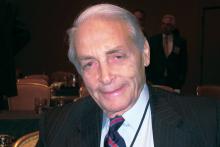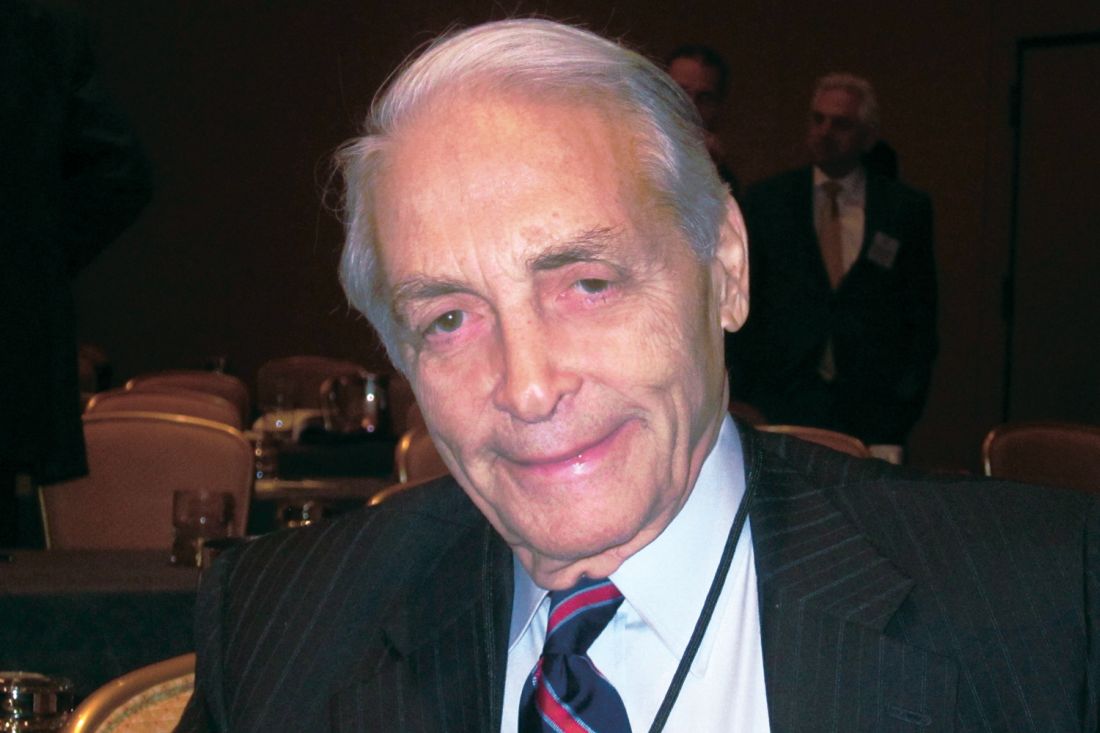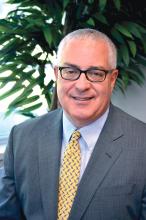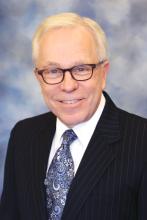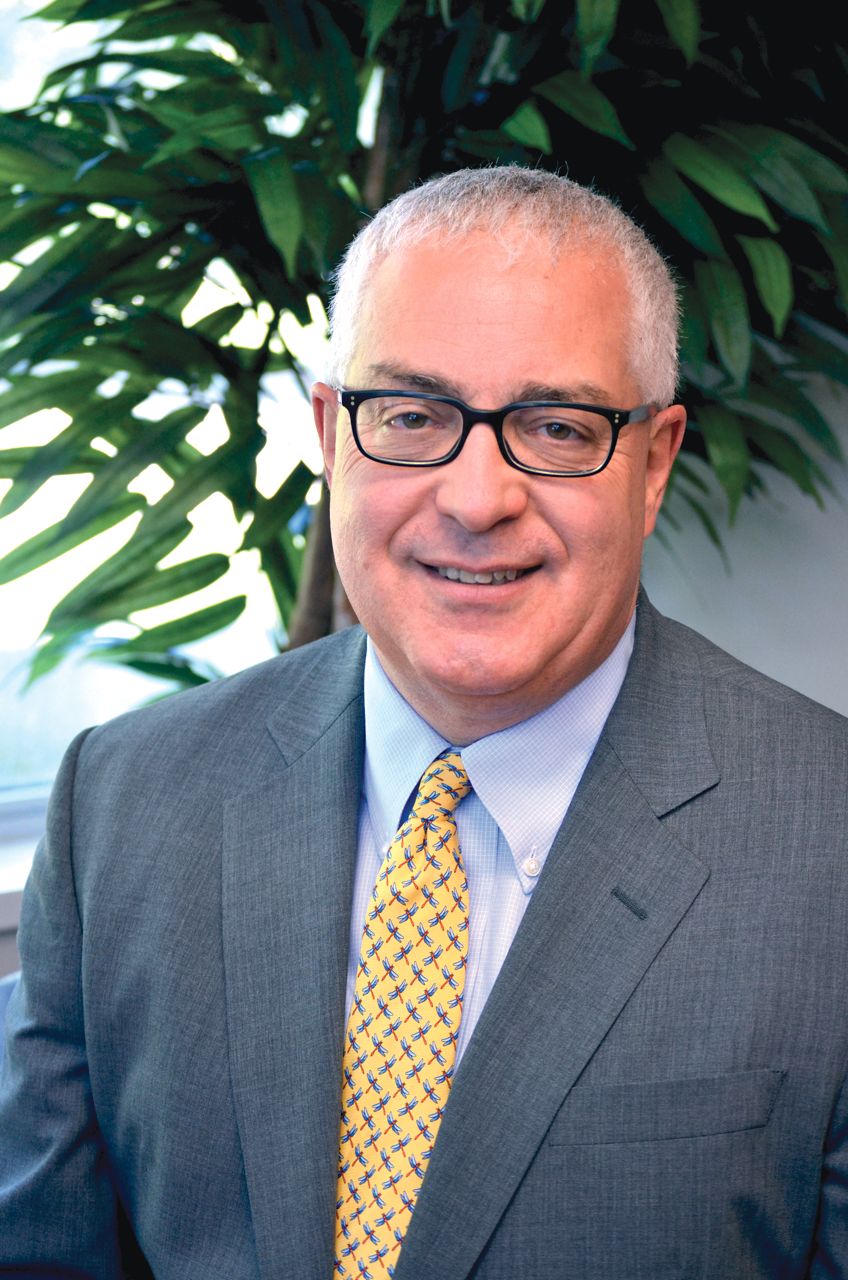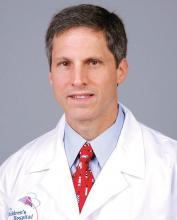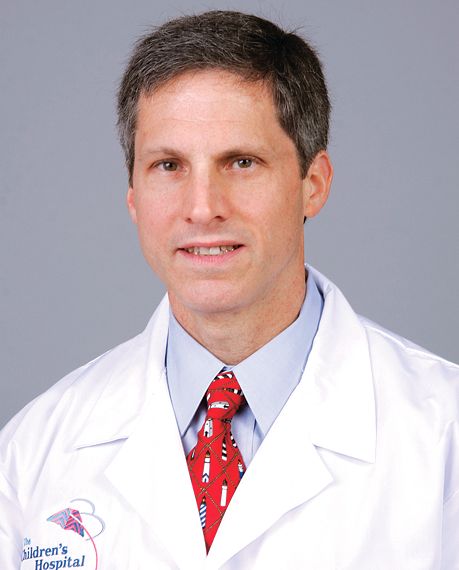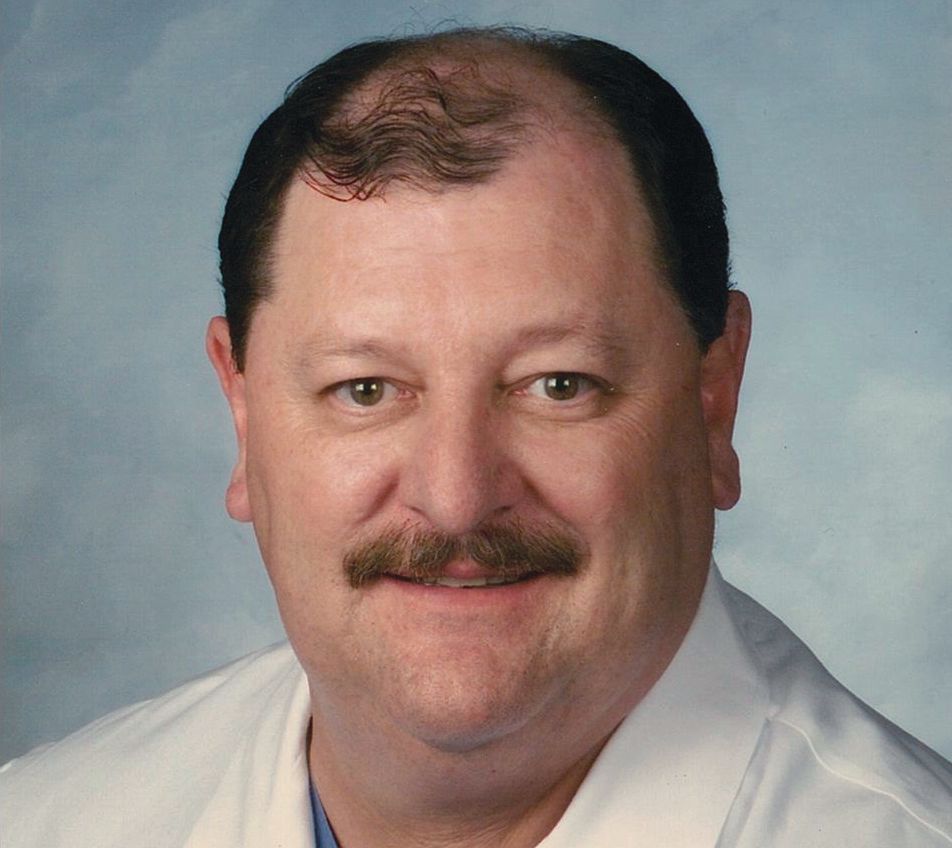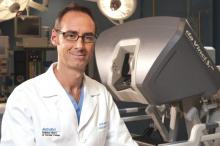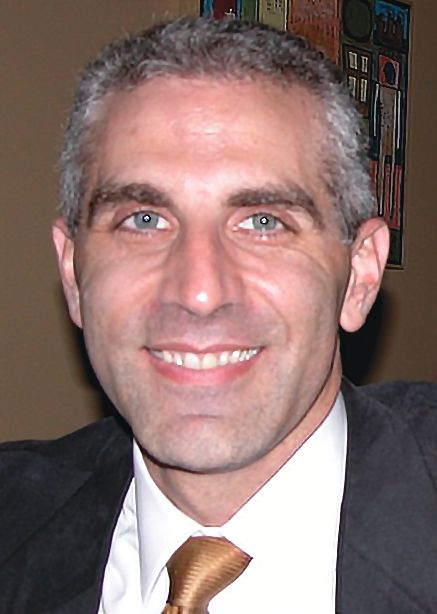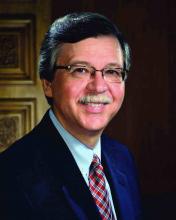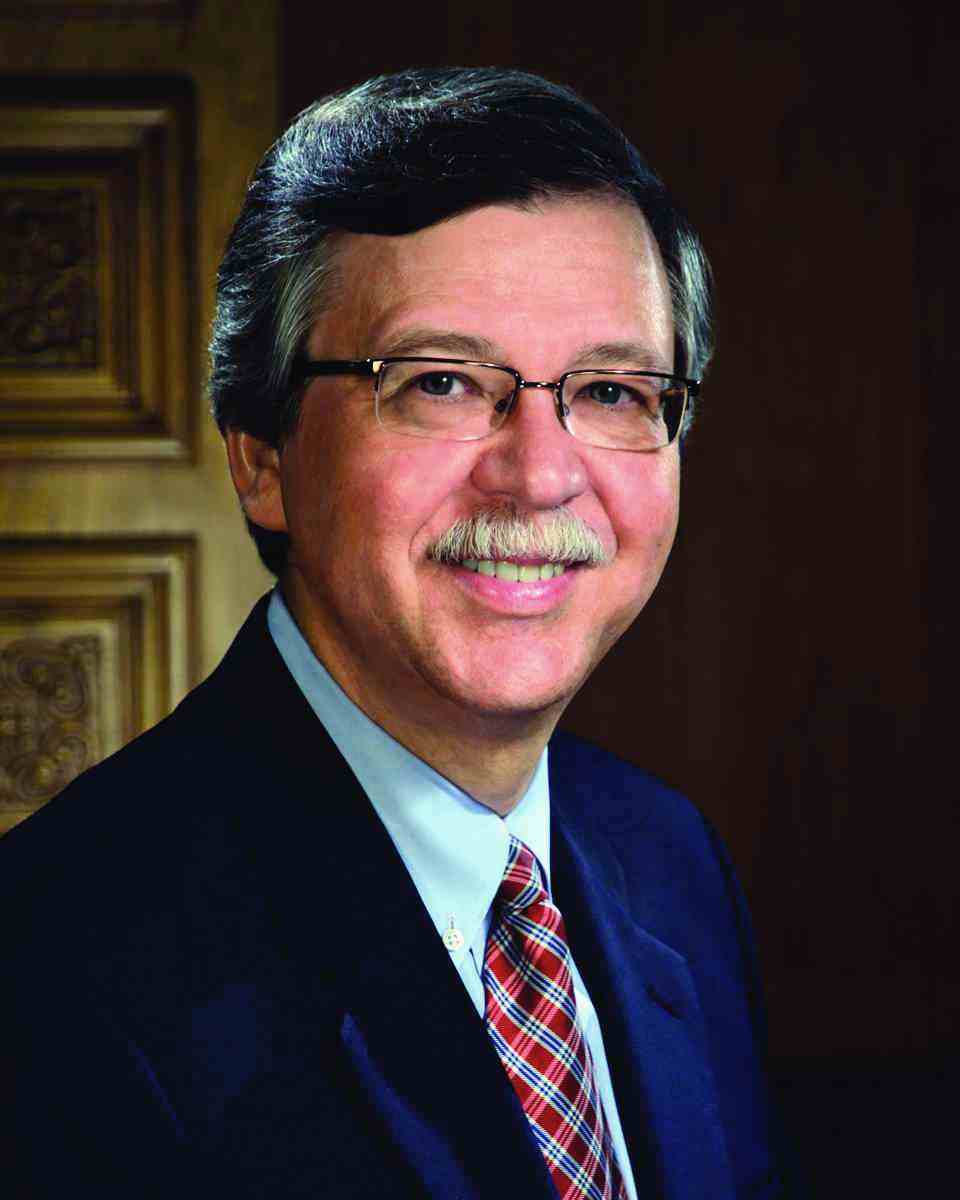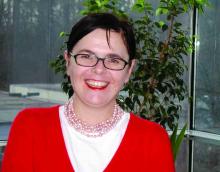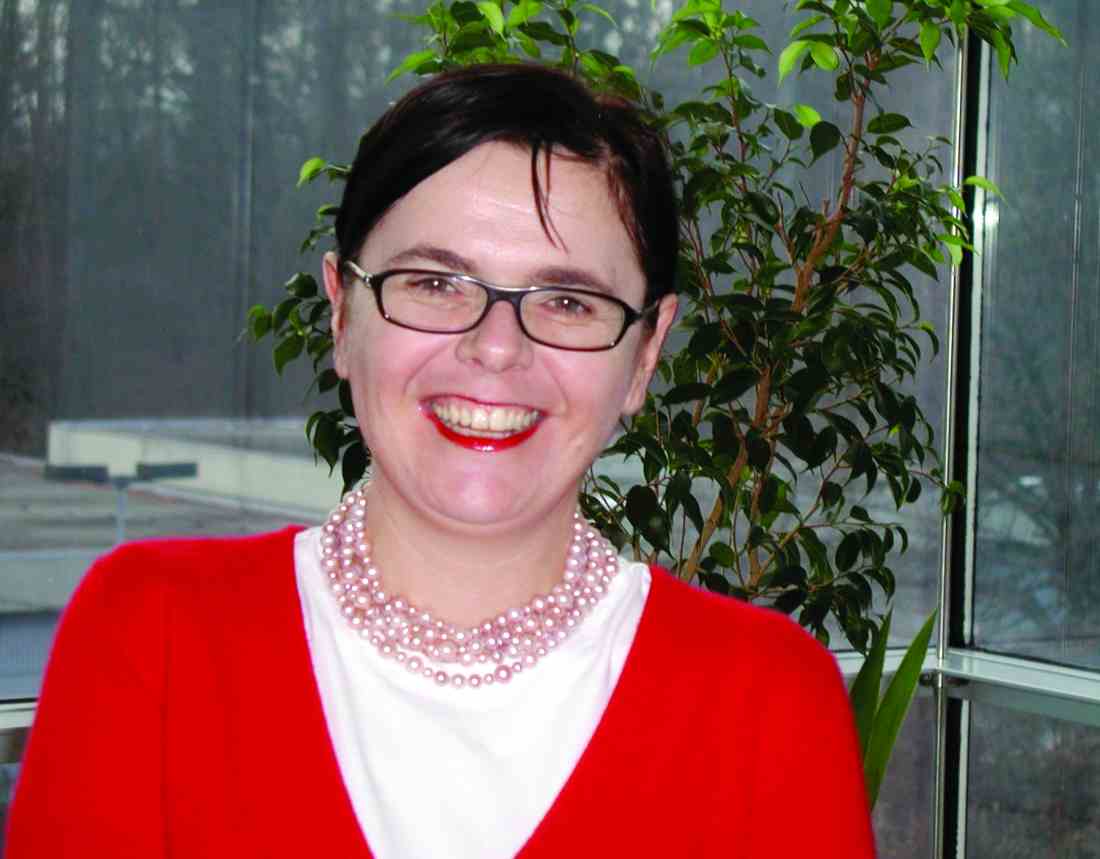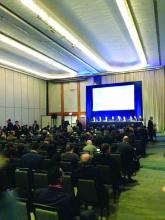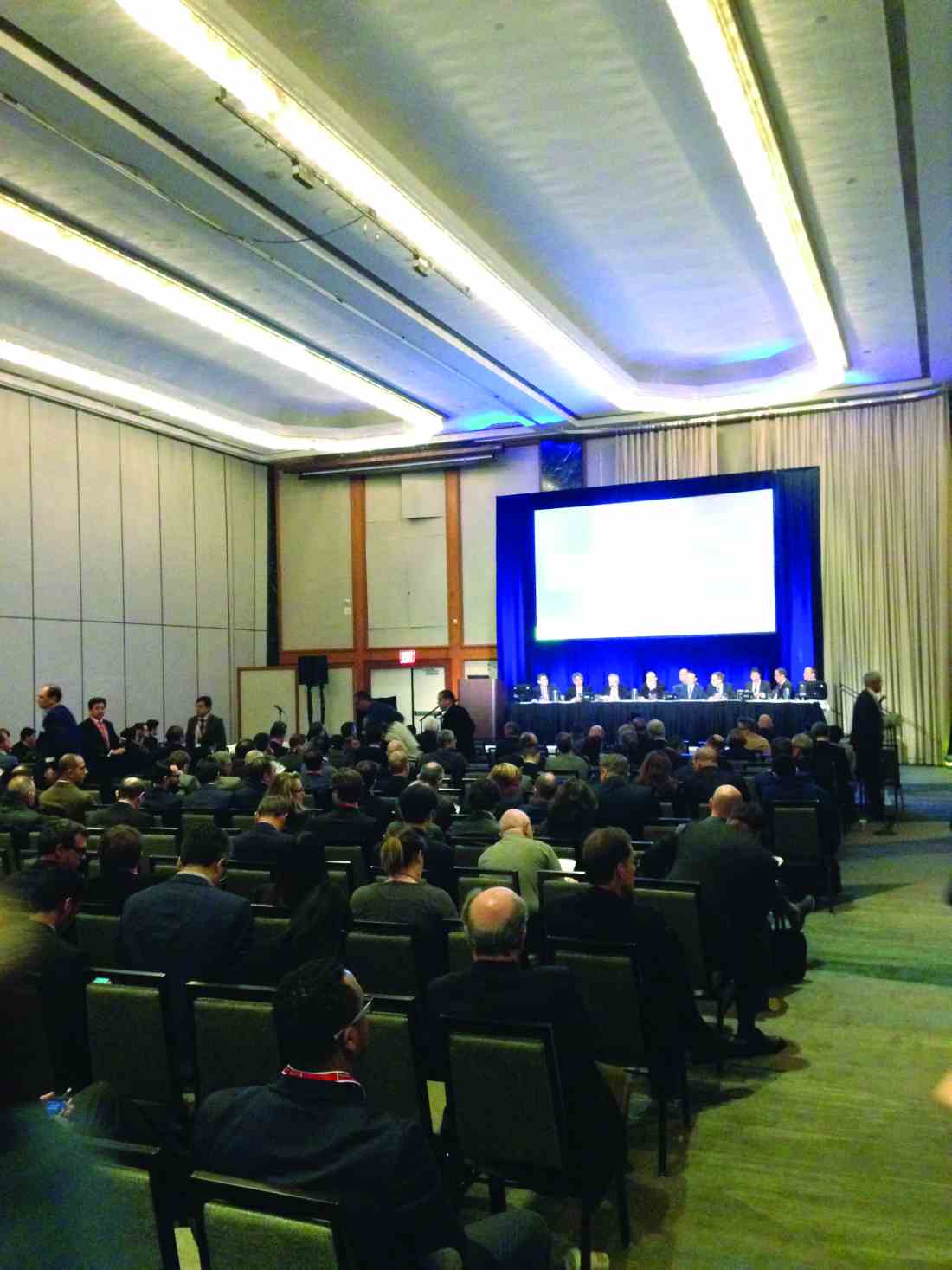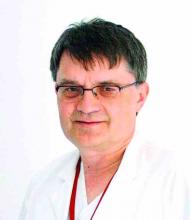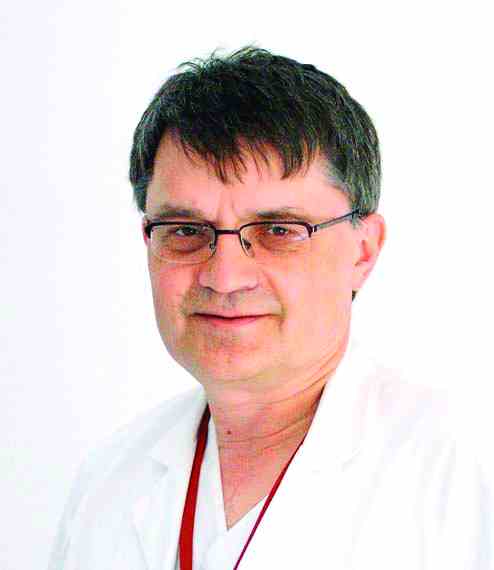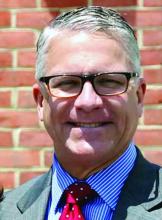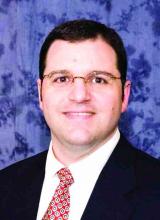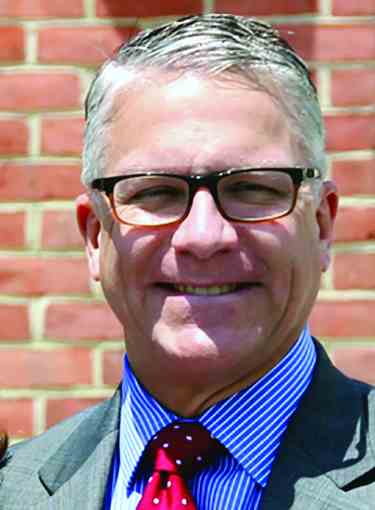User login
Welcome to the 2017 VEITHsymposium
Welcome to the 44th annual Vascular & Endovascular, Issues, Techniques and Horizons Symposium (VEITHsymposium). This year’s program promises to be one of the best, most comprehensive, and most thought-provoking of any of our meetings. This year we celebrate our 44th anniversary and have introduced several improvements.
Nearly 600 international clinician/educators have gathered to provide attendees with the latest topics and advances that are important to the global vascular community. These data span the breadth of vascular diseases, diagnostic procedures, medical treatments, interventional procedures and open surgical advances for treating vascular disease. As is the hallmark of the VEITHsymposium, the 5-day program will run from dawn to dusk daily and will be fully captured in our online library.
With more than 1,000 rapid-fire, 5-6-minute presentations delivered in over 100 sessions, symposium faculty will cover the full range of topics pertinent to clinical practice and research, including the latest pharmacologic, radiologic, surgical, and endovascular techniques. They will discuss when the various treatment options are justified and, importantly, when they are not.
Controversial issues will be approached from multiple perspectives to ensure a balanced, unbiased exposure of topics and to provide audience members with the information they need to make informed choices in their own practices.
This year our meeting continues its increased emphasis on venous disease. Three full days of the meeting are developments in venous disease of all sorts and active endovascular treatments in this rapidly expanding area of opportunity.
Some of the program’s other hot topics will be the continuing controversies surrounding parallel grafts (chimneys, snorkel and sandwich grafts) versus fenestrated and branched endografts; multilayer open stents; new developments in carotid stenting; new developments in the treatment of aortic dissections; a half day devoted to the management of arteriovenous malformations (AVMs); new developments in the endovascular treatment of lower-extremity ischemia, particularly with below the knee disease; the latest developments in EVAR and TEVAR including experiences with a plethora of new endovascular grafts and devices that have appeared on the scene in the last year; and improvements in the medical treatment of vascular disease and vascular patients undergoing surgery and other interventions. Important issues to all vascular specialists and outpatient vascular treatment will also be highlighted.
This year’s program will include a special full morning session on Tuesday, focused in the morning on management options for pulmonary embolism led by Dr. Michael R. Jaff. The afternoon part of the day will focus on new developments in the diagnosis and management of vascular malformations, and will be led by Dr. Wayne Yakes, Dr. Krassi Ivancev and Dr. Robert Vogelzang.
This year there will also be sessions devoted to crucial issues for vascular specialists including changing relationships with government and the FDA and how to survive under new federal reimbursement rules and regulations. Our physician/educators will also offer a glimpse into some new techniques and technologies that have been available overseas, but are just gaining approval in the United States.
Attendees will notice some other exciting changes or additions to this year’s program. We have again included a Job Fair Program on Friday in the Americas Hall 1 on the 3rd floor. In addition, there will be more breaks in the schedule to encourage exploration of state-of-the-art technology, products, and services available in the Exhibit areas and Pavilions. The Exhibit Halls are crowded with displays and booths of particular interest to vascular surgeons and vascular specialists. The Pavilions and Exhibits also offer attendees the chance to meet faculty and to network with other attendees and industry partners. This is one place to learn more about exciting new technologies and developments in our field.
Other additions to our meeting this year will be expanding pavilions as well as an expanded Innovations and Investment Summit which facilitates interaction between innovators, industry and investors. This non-CME Session will be held from 7:45 a.m. to 11:55 a.m. on Thursday, November 17th in the Concourse A on the Concourse Level and will be led by Dr. Kenneth Ouriel, Dr. Jean Bismuth and Christopher Cheng.
This year will feature an improved VEITHsymposium mobile app, provided courtesy of Cook Medical. Download the app for your iPhone, iPad or Android phone or tablet! Search the App Store (iPhone/iPad) or Google Play Store (Android) for “VEITHsymposium 2017” and install the app. You will be able to access the complete program, create your personal program, add your notes, view the location of sessions and exhibitors on the floor plan, and much more. After you have installed the app and opened it for the first time, you can continue to use it offline. To receive the latest updates and announcements, you will need to be connected to the internet.
In addition, there will be expanded Associate Faculty programs which will give younger and less well-known vascular specialists the opportunity to present their work at the podium with leading experts as session moderators.
Again this year, an Online Library will be available for a minimal fee of $75 for clinical meeting attendees and will include access to most talks, slides, videos, and panels from the meeting. This Library will enable all attendees to see and hear key presentations they may miss because of the concurrent sessions or other reasons – or want to see and hear again after the meeting. This Library will be available 10-14 days after the meeting. Attendees should note in their program talks they wish to hear but could not, and then revisit the missed talks on the Online Library which is indexed exactly to the program. The talks are also indexed in the Library by presenter, topic, or session. This Library is a great resource for study, research or review for any purpose.
On behalf of all the meeting Co-Chairmen and our entire staff, we greatly appreciate you coming to our meeting. We hope it is our best meeting ever and that you find it educational, most useful and exciting so that you return next year.
Welcome to the 44th annual Vascular & Endovascular, Issues, Techniques and Horizons Symposium (VEITHsymposium). This year’s program promises to be one of the best, most comprehensive, and most thought-provoking of any of our meetings. This year we celebrate our 44th anniversary and have introduced several improvements.
Nearly 600 international clinician/educators have gathered to provide attendees with the latest topics and advances that are important to the global vascular community. These data span the breadth of vascular diseases, diagnostic procedures, medical treatments, interventional procedures and open surgical advances for treating vascular disease. As is the hallmark of the VEITHsymposium, the 5-day program will run from dawn to dusk daily and will be fully captured in our online library.
With more than 1,000 rapid-fire, 5-6-minute presentations delivered in over 100 sessions, symposium faculty will cover the full range of topics pertinent to clinical practice and research, including the latest pharmacologic, radiologic, surgical, and endovascular techniques. They will discuss when the various treatment options are justified and, importantly, when they are not.
Controversial issues will be approached from multiple perspectives to ensure a balanced, unbiased exposure of topics and to provide audience members with the information they need to make informed choices in their own practices.
This year our meeting continues its increased emphasis on venous disease. Three full days of the meeting are developments in venous disease of all sorts and active endovascular treatments in this rapidly expanding area of opportunity.
Some of the program’s other hot topics will be the continuing controversies surrounding parallel grafts (chimneys, snorkel and sandwich grafts) versus fenestrated and branched endografts; multilayer open stents; new developments in carotid stenting; new developments in the treatment of aortic dissections; a half day devoted to the management of arteriovenous malformations (AVMs); new developments in the endovascular treatment of lower-extremity ischemia, particularly with below the knee disease; the latest developments in EVAR and TEVAR including experiences with a plethora of new endovascular grafts and devices that have appeared on the scene in the last year; and improvements in the medical treatment of vascular disease and vascular patients undergoing surgery and other interventions. Important issues to all vascular specialists and outpatient vascular treatment will also be highlighted.
This year’s program will include a special full morning session on Tuesday, focused in the morning on management options for pulmonary embolism led by Dr. Michael R. Jaff. The afternoon part of the day will focus on new developments in the diagnosis and management of vascular malformations, and will be led by Dr. Wayne Yakes, Dr. Krassi Ivancev and Dr. Robert Vogelzang.
This year there will also be sessions devoted to crucial issues for vascular specialists including changing relationships with government and the FDA and how to survive under new federal reimbursement rules and regulations. Our physician/educators will also offer a glimpse into some new techniques and technologies that have been available overseas, but are just gaining approval in the United States.
Attendees will notice some other exciting changes or additions to this year’s program. We have again included a Job Fair Program on Friday in the Americas Hall 1 on the 3rd floor. In addition, there will be more breaks in the schedule to encourage exploration of state-of-the-art technology, products, and services available in the Exhibit areas and Pavilions. The Exhibit Halls are crowded with displays and booths of particular interest to vascular surgeons and vascular specialists. The Pavilions and Exhibits also offer attendees the chance to meet faculty and to network with other attendees and industry partners. This is one place to learn more about exciting new technologies and developments in our field.
Other additions to our meeting this year will be expanding pavilions as well as an expanded Innovations and Investment Summit which facilitates interaction between innovators, industry and investors. This non-CME Session will be held from 7:45 a.m. to 11:55 a.m. on Thursday, November 17th in the Concourse A on the Concourse Level and will be led by Dr. Kenneth Ouriel, Dr. Jean Bismuth and Christopher Cheng.
This year will feature an improved VEITHsymposium mobile app, provided courtesy of Cook Medical. Download the app for your iPhone, iPad or Android phone or tablet! Search the App Store (iPhone/iPad) or Google Play Store (Android) for “VEITHsymposium 2017” and install the app. You will be able to access the complete program, create your personal program, add your notes, view the location of sessions and exhibitors on the floor plan, and much more. After you have installed the app and opened it for the first time, you can continue to use it offline. To receive the latest updates and announcements, you will need to be connected to the internet.
In addition, there will be expanded Associate Faculty programs which will give younger and less well-known vascular specialists the opportunity to present their work at the podium with leading experts as session moderators.
Again this year, an Online Library will be available for a minimal fee of $75 for clinical meeting attendees and will include access to most talks, slides, videos, and panels from the meeting. This Library will enable all attendees to see and hear key presentations they may miss because of the concurrent sessions or other reasons – or want to see and hear again after the meeting. This Library will be available 10-14 days after the meeting. Attendees should note in their program talks they wish to hear but could not, and then revisit the missed talks on the Online Library which is indexed exactly to the program. The talks are also indexed in the Library by presenter, topic, or session. This Library is a great resource for study, research or review for any purpose.
On behalf of all the meeting Co-Chairmen and our entire staff, we greatly appreciate you coming to our meeting. We hope it is our best meeting ever and that you find it educational, most useful and exciting so that you return next year.
Welcome to the 44th annual Vascular & Endovascular, Issues, Techniques and Horizons Symposium (VEITHsymposium). This year’s program promises to be one of the best, most comprehensive, and most thought-provoking of any of our meetings. This year we celebrate our 44th anniversary and have introduced several improvements.
Nearly 600 international clinician/educators have gathered to provide attendees with the latest topics and advances that are important to the global vascular community. These data span the breadth of vascular diseases, diagnostic procedures, medical treatments, interventional procedures and open surgical advances for treating vascular disease. As is the hallmark of the VEITHsymposium, the 5-day program will run from dawn to dusk daily and will be fully captured in our online library.
With more than 1,000 rapid-fire, 5-6-minute presentations delivered in over 100 sessions, symposium faculty will cover the full range of topics pertinent to clinical practice and research, including the latest pharmacologic, radiologic, surgical, and endovascular techniques. They will discuss when the various treatment options are justified and, importantly, when they are not.
Controversial issues will be approached from multiple perspectives to ensure a balanced, unbiased exposure of topics and to provide audience members with the information they need to make informed choices in their own practices.
This year our meeting continues its increased emphasis on venous disease. Three full days of the meeting are developments in venous disease of all sorts and active endovascular treatments in this rapidly expanding area of opportunity.
Some of the program’s other hot topics will be the continuing controversies surrounding parallel grafts (chimneys, snorkel and sandwich grafts) versus fenestrated and branched endografts; multilayer open stents; new developments in carotid stenting; new developments in the treatment of aortic dissections; a half day devoted to the management of arteriovenous malformations (AVMs); new developments in the endovascular treatment of lower-extremity ischemia, particularly with below the knee disease; the latest developments in EVAR and TEVAR including experiences with a plethora of new endovascular grafts and devices that have appeared on the scene in the last year; and improvements in the medical treatment of vascular disease and vascular patients undergoing surgery and other interventions. Important issues to all vascular specialists and outpatient vascular treatment will also be highlighted.
This year’s program will include a special full morning session on Tuesday, focused in the morning on management options for pulmonary embolism led by Dr. Michael R. Jaff. The afternoon part of the day will focus on new developments in the diagnosis and management of vascular malformations, and will be led by Dr. Wayne Yakes, Dr. Krassi Ivancev and Dr. Robert Vogelzang.
This year there will also be sessions devoted to crucial issues for vascular specialists including changing relationships with government and the FDA and how to survive under new federal reimbursement rules and regulations. Our physician/educators will also offer a glimpse into some new techniques and technologies that have been available overseas, but are just gaining approval in the United States.
Attendees will notice some other exciting changes or additions to this year’s program. We have again included a Job Fair Program on Friday in the Americas Hall 1 on the 3rd floor. In addition, there will be more breaks in the schedule to encourage exploration of state-of-the-art technology, products, and services available in the Exhibit areas and Pavilions. The Exhibit Halls are crowded with displays and booths of particular interest to vascular surgeons and vascular specialists. The Pavilions and Exhibits also offer attendees the chance to meet faculty and to network with other attendees and industry partners. This is one place to learn more about exciting new technologies and developments in our field.
Other additions to our meeting this year will be expanding pavilions as well as an expanded Innovations and Investment Summit which facilitates interaction between innovators, industry and investors. This non-CME Session will be held from 7:45 a.m. to 11:55 a.m. on Thursday, November 17th in the Concourse A on the Concourse Level and will be led by Dr. Kenneth Ouriel, Dr. Jean Bismuth and Christopher Cheng.
This year will feature an improved VEITHsymposium mobile app, provided courtesy of Cook Medical. Download the app for your iPhone, iPad or Android phone or tablet! Search the App Store (iPhone/iPad) or Google Play Store (Android) for “VEITHsymposium 2017” and install the app. You will be able to access the complete program, create your personal program, add your notes, view the location of sessions and exhibitors on the floor plan, and much more. After you have installed the app and opened it for the first time, you can continue to use it offline. To receive the latest updates and announcements, you will need to be connected to the internet.
In addition, there will be expanded Associate Faculty programs which will give younger and less well-known vascular specialists the opportunity to present their work at the podium with leading experts as session moderators.
Again this year, an Online Library will be available for a minimal fee of $75 for clinical meeting attendees and will include access to most talks, slides, videos, and panels from the meeting. This Library will enable all attendees to see and hear key presentations they may miss because of the concurrent sessions or other reasons – or want to see and hear again after the meeting. This Library will be available 10-14 days after the meeting. Attendees should note in their program talks they wish to hear but could not, and then revisit the missed talks on the Online Library which is indexed exactly to the program. The talks are also indexed in the Library by presenter, topic, or session. This Library is a great resource for study, research or review for any purpose.
On behalf of all the meeting Co-Chairmen and our entire staff, we greatly appreciate you coming to our meeting. We hope it is our best meeting ever and that you find it educational, most useful and exciting so that you return next year.
Session to Highlight Recent Advances in Deep Vein Disease Management
Contemporary management of what has been a difficult problem – deep venous obstruction – will be highlighted during “Femoro-Iliocaval Interventional Strategies to Reduce Venous Hypertension, Hot Ideas for Recanalizing Chronic Total Occlusions” on Friday morning.
“This session will focus on recent advances in thinking and technique in the intervention and treatment of symptomatic deep vein disease,” said co-moderator Dr. Paul J. Gagne, clinical associate professor at New York University School of Medicine and chief of vascular surgery Norwalk Hospital. “It will highlight what can be done to help patients who, until this past decade, had no hope of regaining their quality of life.
“The session will focus on pathology of post-thrombotic venous obstruction, as well as the important principles of reconstruction,” added co-moderator Dr. Anthony J. Comerota, adjunct professor of surgery at the University of Michigan. “Practitioners involved in the management of these patients will find that their understanding of the disease process will be expanded. They will also receive technical treatment tips to improve patient outcomes.”
Dr. Comerota will begin the session with a discussion of post-thrombotic venous obstruction tissue. Dr. Seshadri Raju of the St. Dominic Center and Rane Center in Jackson, will cover hyperdilation as a reinterventional technique. Dr. Stephen A. Black of the University of London and Guys and St. Thomas Hospital will speak on reasoning behind deep vein surgical reconstruction. There will also be a video technique demonstration by Dr. Ramesh K. Tripathi of the University of Sunshine Coast in Sippy Downs, Australia, on endovenectomy and iliac stent placement.
Stents, stent trials, and off-stent use will be a major focus during the balance of the session. “Presently, no stent is approved for use in the venous system. However, there has been a great deal of effort invested in studying stents of different design, which have varying physical characteristics,” noted Dr. Comerota. “These stents will be discussed and the latest data from clinical trials will be presented. Session presentations by experts will offer enormous advantage to attendees.”
Dr. Erin H. Murphy, director of the Venous and Lymphatic Institute of Sanger Heart and Vascular in Charlotte, will present three talks, including discussions of the diagnostic and stenting implications of vein shape and the Abre stent and trial design. Dr. Michael K.W. Lichtenberg of Klinikum Arnsberg in Germany will highlight patency rates and clinical results of the Veniti VICI and Venovo Venous stents. Dr. Lowell S. Kabnick of New York University Medical School and Medical Center will cover whether stent lumen shape matters as viewed via the VIRTUS Feasibility Trial.
“Dr. Lichtenberg’s updates on new venous stents available in Europe and in trials in the U.S. will provide the audience with important information about technologies soon to be commercialized in the U.S. and abroad,” Dr. Gagne said. “The discussion by Dr. Murphy on veins being elliptical conduits is an important concept specific to deep vein disease.”
The final section will include presentations by Dr. Raju, Jose I. Almeida, MD, of the University of Miami School of Medicine and Miami Vein Center, and Rick De Graaf, MD, from Maastricht University Medical Center. Topics will include z-stent extension into the cava, crossing femoro-iliocaval chronic total occlusions, and confluence, femoral vein, and single inflow vein stenting.
“Patients with symptomatic deep venous insufficiency now have expanding options for treatment with both increasingly improved tools and understanding of the technical factors that result in successful interventions,” explained Dr. Gagne. “The session will provide guidance from thought leaders in the proper technique and thought process for achieving successful revascularization of deep vein occlusive disease.”
“The attendees will receive the latest information on the current techniques of proximal venous recanalization,” concluded Dr. Comerota. “Not only will their understanding of the disease process be strengthened, but they will also be exposed to the nuances of diagnosis and treatment, which are crucial to successful short- and long-term patient management.”
Contemporary management of what has been a difficult problem – deep venous obstruction – will be highlighted during “Femoro-Iliocaval Interventional Strategies to Reduce Venous Hypertension, Hot Ideas for Recanalizing Chronic Total Occlusions” on Friday morning.
“This session will focus on recent advances in thinking and technique in the intervention and treatment of symptomatic deep vein disease,” said co-moderator Dr. Paul J. Gagne, clinical associate professor at New York University School of Medicine and chief of vascular surgery Norwalk Hospital. “It will highlight what can be done to help patients who, until this past decade, had no hope of regaining their quality of life.
“The session will focus on pathology of post-thrombotic venous obstruction, as well as the important principles of reconstruction,” added co-moderator Dr. Anthony J. Comerota, adjunct professor of surgery at the University of Michigan. “Practitioners involved in the management of these patients will find that their understanding of the disease process will be expanded. They will also receive technical treatment tips to improve patient outcomes.”
Dr. Comerota will begin the session with a discussion of post-thrombotic venous obstruction tissue. Dr. Seshadri Raju of the St. Dominic Center and Rane Center in Jackson, will cover hyperdilation as a reinterventional technique. Dr. Stephen A. Black of the University of London and Guys and St. Thomas Hospital will speak on reasoning behind deep vein surgical reconstruction. There will also be a video technique demonstration by Dr. Ramesh K. Tripathi of the University of Sunshine Coast in Sippy Downs, Australia, on endovenectomy and iliac stent placement.
Stents, stent trials, and off-stent use will be a major focus during the balance of the session. “Presently, no stent is approved for use in the venous system. However, there has been a great deal of effort invested in studying stents of different design, which have varying physical characteristics,” noted Dr. Comerota. “These stents will be discussed and the latest data from clinical trials will be presented. Session presentations by experts will offer enormous advantage to attendees.”
Dr. Erin H. Murphy, director of the Venous and Lymphatic Institute of Sanger Heart and Vascular in Charlotte, will present three talks, including discussions of the diagnostic and stenting implications of vein shape and the Abre stent and trial design. Dr. Michael K.W. Lichtenberg of Klinikum Arnsberg in Germany will highlight patency rates and clinical results of the Veniti VICI and Venovo Venous stents. Dr. Lowell S. Kabnick of New York University Medical School and Medical Center will cover whether stent lumen shape matters as viewed via the VIRTUS Feasibility Trial.
“Dr. Lichtenberg’s updates on new venous stents available in Europe and in trials in the U.S. will provide the audience with important information about technologies soon to be commercialized in the U.S. and abroad,” Dr. Gagne said. “The discussion by Dr. Murphy on veins being elliptical conduits is an important concept specific to deep vein disease.”
The final section will include presentations by Dr. Raju, Jose I. Almeida, MD, of the University of Miami School of Medicine and Miami Vein Center, and Rick De Graaf, MD, from Maastricht University Medical Center. Topics will include z-stent extension into the cava, crossing femoro-iliocaval chronic total occlusions, and confluence, femoral vein, and single inflow vein stenting.
“Patients with symptomatic deep venous insufficiency now have expanding options for treatment with both increasingly improved tools and understanding of the technical factors that result in successful interventions,” explained Dr. Gagne. “The session will provide guidance from thought leaders in the proper technique and thought process for achieving successful revascularization of deep vein occlusive disease.”
“The attendees will receive the latest information on the current techniques of proximal venous recanalization,” concluded Dr. Comerota. “Not only will their understanding of the disease process be strengthened, but they will also be exposed to the nuances of diagnosis and treatment, which are crucial to successful short- and long-term patient management.”
Contemporary management of what has been a difficult problem – deep venous obstruction – will be highlighted during “Femoro-Iliocaval Interventional Strategies to Reduce Venous Hypertension, Hot Ideas for Recanalizing Chronic Total Occlusions” on Friday morning.
“This session will focus on recent advances in thinking and technique in the intervention and treatment of symptomatic deep vein disease,” said co-moderator Dr. Paul J. Gagne, clinical associate professor at New York University School of Medicine and chief of vascular surgery Norwalk Hospital. “It will highlight what can be done to help patients who, until this past decade, had no hope of regaining their quality of life.
“The session will focus on pathology of post-thrombotic venous obstruction, as well as the important principles of reconstruction,” added co-moderator Dr. Anthony J. Comerota, adjunct professor of surgery at the University of Michigan. “Practitioners involved in the management of these patients will find that their understanding of the disease process will be expanded. They will also receive technical treatment tips to improve patient outcomes.”
Dr. Comerota will begin the session with a discussion of post-thrombotic venous obstruction tissue. Dr. Seshadri Raju of the St. Dominic Center and Rane Center in Jackson, will cover hyperdilation as a reinterventional technique. Dr. Stephen A. Black of the University of London and Guys and St. Thomas Hospital will speak on reasoning behind deep vein surgical reconstruction. There will also be a video technique demonstration by Dr. Ramesh K. Tripathi of the University of Sunshine Coast in Sippy Downs, Australia, on endovenectomy and iliac stent placement.
Stents, stent trials, and off-stent use will be a major focus during the balance of the session. “Presently, no stent is approved for use in the venous system. However, there has been a great deal of effort invested in studying stents of different design, which have varying physical characteristics,” noted Dr. Comerota. “These stents will be discussed and the latest data from clinical trials will be presented. Session presentations by experts will offer enormous advantage to attendees.”
Dr. Erin H. Murphy, director of the Venous and Lymphatic Institute of Sanger Heart and Vascular in Charlotte, will present three talks, including discussions of the diagnostic and stenting implications of vein shape and the Abre stent and trial design. Dr. Michael K.W. Lichtenberg of Klinikum Arnsberg in Germany will highlight patency rates and clinical results of the Veniti VICI and Venovo Venous stents. Dr. Lowell S. Kabnick of New York University Medical School and Medical Center will cover whether stent lumen shape matters as viewed via the VIRTUS Feasibility Trial.
“Dr. Lichtenberg’s updates on new venous stents available in Europe and in trials in the U.S. will provide the audience with important information about technologies soon to be commercialized in the U.S. and abroad,” Dr. Gagne said. “The discussion by Dr. Murphy on veins being elliptical conduits is an important concept specific to deep vein disease.”
The final section will include presentations by Dr. Raju, Jose I. Almeida, MD, of the University of Miami School of Medicine and Miami Vein Center, and Rick De Graaf, MD, from Maastricht University Medical Center. Topics will include z-stent extension into the cava, crossing femoro-iliocaval chronic total occlusions, and confluence, femoral vein, and single inflow vein stenting.
“Patients with symptomatic deep venous insufficiency now have expanding options for treatment with both increasingly improved tools and understanding of the technical factors that result in successful interventions,” explained Dr. Gagne. “The session will provide guidance from thought leaders in the proper technique and thought process for achieving successful revascularization of deep vein occlusive disease.”
“The attendees will receive the latest information on the current techniques of proximal venous recanalization,” concluded Dr. Comerota. “Not only will their understanding of the disease process be strengthened, but they will also be exposed to the nuances of diagnosis and treatment, which are crucial to successful short- and long-term patient management.”
New Devices and Gear Support Safety First
New developments in techniques and technology, particularly the use of simulators and virtual reality, are poised to improve radiation safety and will be showcased in the session, “Radiation Safety; Imaging, New Concepts and Devices,” on Thursday afternoon.
The session will be co-moderated by Dr. Evan C. Lipsitz, associate professor of surgery at Albert Einstein College of Medicine, and chief of the division of vascular surgery at Montefiore Medical Center, New York, and Dr. Lars B. Lonn, professor of vascular surgery and interventional radiology at the University of Copenhagen.
Dr. Götz M. Richter, professor of radiology, Klinik für Diagnostische und Interventionelle Radiologie, Stuttgart, Germany, will start off the session with tips on how to reduce radiation exposure during complex aortic procedures, and how virtual guidance systems will help. Next, Dr. Armando C. Lobato, post-graduate professor, Federal University of São Paulo, will speak on “Endovascular Repair of AAAs with Common Iliac Aneurysms: Comparison of Sandwich Grafts vs. Hypogastric Exclusion vs. Bell Bottom Technique.”
Safety gear continues to evolve, but Dr. Lonn will discuss the limitations of current equipment in his talk, “‘Light Weight’ Radiation Protective Gear (Caps, Glasses, Lead Gowns) Is a Misnomer: These Devices Fall Short: How Should Vascular Specialists Best Protect Their Brain, Eyes and Body From Radiation.”
Dr. Kyung Cho, William Martel Emeritus Professor of Radiology, University of Michigan, provides additional tips and tricks for safely performing CO2 angiography and CO2 guided interventions for the treatment of lower extremity and abdominal arterial lesions.
The session also includes presentations on the use of virtual and augmented reality, and how these technologies can be used to enhance operator radiation safety and improve surgeons’ technical skills without compromising patient safety. Dr. Lonn will begin this portion of the session with a talk on how a simulation system can help promote operator radiation safety.
Dr. Jan M.M. Heyligers, consultant vascular surgeon, Elisabeth Twee-Steden Hospital, will continue the subject the virtual reality, taking on the topic of “Virtual Reality, Augmented Reality, and High Resolution 3D-3D Imaging: What Are They and What Will Their Value Be?
Dr. Fabien Thaveau, professor of vascular surgery, Medical School of Strasbourg, will discuss the specifics of a particular system in a review of the Medtronic Tour Guide System and its potential value when used to assist with challenging catheterizations and procedures.
The session will then feature a presentation by Dr. Timothy K. Liem, professor of surgery, Oregon Health & Science University, on how to manage anticoagulation to avoid postoperative hemorrhage and a discussion of the use of a pressurized cadaver model to augment open vascular training by Dr. Christian Ochoa, assistant professor of surgery, Keck Medical Center of University of Southern California. The pressurized model is designed to simulate patient bleeding.
The take-home message from the session is “that reducing radiation exposure requires a multifaceted approach and that operators must be vigilant and keep abreast of new developments to achieve maximum effectiveness,” Dr. Lipsitz concluded.
New developments in techniques and technology, particularly the use of simulators and virtual reality, are poised to improve radiation safety and will be showcased in the session, “Radiation Safety; Imaging, New Concepts and Devices,” on Thursday afternoon.
The session will be co-moderated by Dr. Evan C. Lipsitz, associate professor of surgery at Albert Einstein College of Medicine, and chief of the division of vascular surgery at Montefiore Medical Center, New York, and Dr. Lars B. Lonn, professor of vascular surgery and interventional radiology at the University of Copenhagen.
Dr. Götz M. Richter, professor of radiology, Klinik für Diagnostische und Interventionelle Radiologie, Stuttgart, Germany, will start off the session with tips on how to reduce radiation exposure during complex aortic procedures, and how virtual guidance systems will help. Next, Dr. Armando C. Lobato, post-graduate professor, Federal University of São Paulo, will speak on “Endovascular Repair of AAAs with Common Iliac Aneurysms: Comparison of Sandwich Grafts vs. Hypogastric Exclusion vs. Bell Bottom Technique.”
Safety gear continues to evolve, but Dr. Lonn will discuss the limitations of current equipment in his talk, “‘Light Weight’ Radiation Protective Gear (Caps, Glasses, Lead Gowns) Is a Misnomer: These Devices Fall Short: How Should Vascular Specialists Best Protect Their Brain, Eyes and Body From Radiation.”
Dr. Kyung Cho, William Martel Emeritus Professor of Radiology, University of Michigan, provides additional tips and tricks for safely performing CO2 angiography and CO2 guided interventions for the treatment of lower extremity and abdominal arterial lesions.
The session also includes presentations on the use of virtual and augmented reality, and how these technologies can be used to enhance operator radiation safety and improve surgeons’ technical skills without compromising patient safety. Dr. Lonn will begin this portion of the session with a talk on how a simulation system can help promote operator radiation safety.
Dr. Jan M.M. Heyligers, consultant vascular surgeon, Elisabeth Twee-Steden Hospital, will continue the subject the virtual reality, taking on the topic of “Virtual Reality, Augmented Reality, and High Resolution 3D-3D Imaging: What Are They and What Will Their Value Be?
Dr. Fabien Thaveau, professor of vascular surgery, Medical School of Strasbourg, will discuss the specifics of a particular system in a review of the Medtronic Tour Guide System and its potential value when used to assist with challenging catheterizations and procedures.
The session will then feature a presentation by Dr. Timothy K. Liem, professor of surgery, Oregon Health & Science University, on how to manage anticoagulation to avoid postoperative hemorrhage and a discussion of the use of a pressurized cadaver model to augment open vascular training by Dr. Christian Ochoa, assistant professor of surgery, Keck Medical Center of University of Southern California. The pressurized model is designed to simulate patient bleeding.
The take-home message from the session is “that reducing radiation exposure requires a multifaceted approach and that operators must be vigilant and keep abreast of new developments to achieve maximum effectiveness,” Dr. Lipsitz concluded.
New developments in techniques and technology, particularly the use of simulators and virtual reality, are poised to improve radiation safety and will be showcased in the session, “Radiation Safety; Imaging, New Concepts and Devices,” on Thursday afternoon.
The session will be co-moderated by Dr. Evan C. Lipsitz, associate professor of surgery at Albert Einstein College of Medicine, and chief of the division of vascular surgery at Montefiore Medical Center, New York, and Dr. Lars B. Lonn, professor of vascular surgery and interventional radiology at the University of Copenhagen.
Dr. Götz M. Richter, professor of radiology, Klinik für Diagnostische und Interventionelle Radiologie, Stuttgart, Germany, will start off the session with tips on how to reduce radiation exposure during complex aortic procedures, and how virtual guidance systems will help. Next, Dr. Armando C. Lobato, post-graduate professor, Federal University of São Paulo, will speak on “Endovascular Repair of AAAs with Common Iliac Aneurysms: Comparison of Sandwich Grafts vs. Hypogastric Exclusion vs. Bell Bottom Technique.”
Safety gear continues to evolve, but Dr. Lonn will discuss the limitations of current equipment in his talk, “‘Light Weight’ Radiation Protective Gear (Caps, Glasses, Lead Gowns) Is a Misnomer: These Devices Fall Short: How Should Vascular Specialists Best Protect Their Brain, Eyes and Body From Radiation.”
Dr. Kyung Cho, William Martel Emeritus Professor of Radiology, University of Michigan, provides additional tips and tricks for safely performing CO2 angiography and CO2 guided interventions for the treatment of lower extremity and abdominal arterial lesions.
The session also includes presentations on the use of virtual and augmented reality, and how these technologies can be used to enhance operator radiation safety and improve surgeons’ technical skills without compromising patient safety. Dr. Lonn will begin this portion of the session with a talk on how a simulation system can help promote operator radiation safety.
Dr. Jan M.M. Heyligers, consultant vascular surgeon, Elisabeth Twee-Steden Hospital, will continue the subject the virtual reality, taking on the topic of “Virtual Reality, Augmented Reality, and High Resolution 3D-3D Imaging: What Are They and What Will Their Value Be?
Dr. Fabien Thaveau, professor of vascular surgery, Medical School of Strasbourg, will discuss the specifics of a particular system in a review of the Medtronic Tour Guide System and its potential value when used to assist with challenging catheterizations and procedures.
The session will then feature a presentation by Dr. Timothy K. Liem, professor of surgery, Oregon Health & Science University, on how to manage anticoagulation to avoid postoperative hemorrhage and a discussion of the use of a pressurized cadaver model to augment open vascular training by Dr. Christian Ochoa, assistant professor of surgery, Keck Medical Center of University of Southern California. The pressurized model is designed to simulate patient bleeding.
The take-home message from the session is “that reducing radiation exposure requires a multifaceted approach and that operators must be vigilant and keep abreast of new developments to achieve maximum effectiveness,” Dr. Lipsitz concluded.
A Tribute to Military Physicians and New Developments in Vascular Trauma
The many contributions of physicians serving in the military to medicine and, vascular traua in particular, will be the focus of the Thursday morning session titled “Tribute To Our Military and Service Physicians Everywhere; New Developments in Vascular Trauma.”
“An understanding of the history of the American military is crucial for the attendees to comprehend the sacrifices, even the ultimate sacrifice, that our men and women in uniform inherently undergo in the service of their country,” said co-moderator Dr. Wayne F. Yakes, director of the Yakes Vascular Malformation Center.
Dr. Yakes will present a session titled “The Naval Battle at Guadalcanal and What It Meant to the Marines Fighting There and to the U.S. Victory in the Pacific.” Dr. Yakes, said “This lecture on the crippling burdens endured successfully by the U.S. Navy and the Marine Corps at Guadalcanal, a critical turning point of the Pacific War, once again demonstrates the prowess and the ‘failure is not an option’ mentality of our brave service men and women.”
Dr. Todd E. Rasmussen, who holds the rank of Colonel in the United States Air Force at F. Edward Hebert School of Medicine and associate dean of research at the Uniformed Services University of Health Sciences, will cover two topics. He will discuss highlights from the recent Endovascula,r and Hybrid Trauma and Bleeding Management Symposium and the impact of wartime trauma practice on preparation for the next terror attack.
An update on the use of Resuscitative Endovascular Balloon Occlusion of the Aorta (REBOA) for control of bleeding will be led by Dr. Joseph J. DuBose, associate professor surgery at the Uniformed Services University of the Health Sciences and director of the USAF BaltimoreC-STARS (Center for the Sustainment of Trauma and Readiness Skills), University of Maryland R Adams Cowley Shock Trauma Center. Finally, Dr. Michael Engelhardt, head of the department of vascular and endovascular surgery at the Military Hospital in Ulm in Germany, will continue the discussion of REBOA and its use in Germany in military and civilian populations.
“Military medicine is extreme in its clinical demands due to the myriad of injuries that can occur in combat but are rarely seen in civilian practice. The requirements of military physician training consitute a high bar but can filter down into surgical practices at major Level I/II trauma centers,” said Dr. Yakes.
The many contributions of physicians serving in the military to medicine and, vascular traua in particular, will be the focus of the Thursday morning session titled “Tribute To Our Military and Service Physicians Everywhere; New Developments in Vascular Trauma.”
“An understanding of the history of the American military is crucial for the attendees to comprehend the sacrifices, even the ultimate sacrifice, that our men and women in uniform inherently undergo in the service of their country,” said co-moderator Dr. Wayne F. Yakes, director of the Yakes Vascular Malformation Center.
Dr. Yakes will present a session titled “The Naval Battle at Guadalcanal and What It Meant to the Marines Fighting There and to the U.S. Victory in the Pacific.” Dr. Yakes, said “This lecture on the crippling burdens endured successfully by the U.S. Navy and the Marine Corps at Guadalcanal, a critical turning point of the Pacific War, once again demonstrates the prowess and the ‘failure is not an option’ mentality of our brave service men and women.”
Dr. Todd E. Rasmussen, who holds the rank of Colonel in the United States Air Force at F. Edward Hebert School of Medicine and associate dean of research at the Uniformed Services University of Health Sciences, will cover two topics. He will discuss highlights from the recent Endovascula,r and Hybrid Trauma and Bleeding Management Symposium and the impact of wartime trauma practice on preparation for the next terror attack.
An update on the use of Resuscitative Endovascular Balloon Occlusion of the Aorta (REBOA) for control of bleeding will be led by Dr. Joseph J. DuBose, associate professor surgery at the Uniformed Services University of the Health Sciences and director of the USAF BaltimoreC-STARS (Center for the Sustainment of Trauma and Readiness Skills), University of Maryland R Adams Cowley Shock Trauma Center. Finally, Dr. Michael Engelhardt, head of the department of vascular and endovascular surgery at the Military Hospital in Ulm in Germany, will continue the discussion of REBOA and its use in Germany in military and civilian populations.
“Military medicine is extreme in its clinical demands due to the myriad of injuries that can occur in combat but are rarely seen in civilian practice. The requirements of military physician training consitute a high bar but can filter down into surgical practices at major Level I/II trauma centers,” said Dr. Yakes.
The many contributions of physicians serving in the military to medicine and, vascular traua in particular, will be the focus of the Thursday morning session titled “Tribute To Our Military and Service Physicians Everywhere; New Developments in Vascular Trauma.”
“An understanding of the history of the American military is crucial for the attendees to comprehend the sacrifices, even the ultimate sacrifice, that our men and women in uniform inherently undergo in the service of their country,” said co-moderator Dr. Wayne F. Yakes, director of the Yakes Vascular Malformation Center.
Dr. Yakes will present a session titled “The Naval Battle at Guadalcanal and What It Meant to the Marines Fighting There and to the U.S. Victory in the Pacific.” Dr. Yakes, said “This lecture on the crippling burdens endured successfully by the U.S. Navy and the Marine Corps at Guadalcanal, a critical turning point of the Pacific War, once again demonstrates the prowess and the ‘failure is not an option’ mentality of our brave service men and women.”
Dr. Todd E. Rasmussen, who holds the rank of Colonel in the United States Air Force at F. Edward Hebert School of Medicine and associate dean of research at the Uniformed Services University of Health Sciences, will cover two topics. He will discuss highlights from the recent Endovascula,r and Hybrid Trauma and Bleeding Management Symposium and the impact of wartime trauma practice on preparation for the next terror attack.
An update on the use of Resuscitative Endovascular Balloon Occlusion of the Aorta (REBOA) for control of bleeding will be led by Dr. Joseph J. DuBose, associate professor surgery at the Uniformed Services University of the Health Sciences and director of the USAF BaltimoreC-STARS (Center for the Sustainment of Trauma and Readiness Skills), University of Maryland R Adams Cowley Shock Trauma Center. Finally, Dr. Michael Engelhardt, head of the department of vascular and endovascular surgery at the Military Hospital in Ulm in Germany, will continue the discussion of REBOA and its use in Germany in military and civilian populations.
“Military medicine is extreme in its clinical demands due to the myriad of injuries that can occur in combat but are rarely seen in civilian practice. The requirements of military physician training consitute a high bar but can filter down into surgical practices at major Level I/II trauma centers,” said Dr. Yakes.
Get Ready for Better Robotics and Virtual Reality
The future of vascular surgery – the procedures themselves and the settings in which they occur – will be showcased in “Vascular Robotics; Imaging Systems; Virtual Reality and Guidance; Hybrid Rooms,” on Thursday afternoon.
The session will be co-moderated by Dr. Mark A. Farber, professor of surgery and radiology at the University of North Carolina, Chapel Hill, and director, UNC Aortic Center, UNC Hospitals, and by Dr. Jean Bismuth, associate professor at Houston Methodist Hospital and Methodist DeBakey Heart & Vascular Center.
“In the new paradigm of minimally invasive vascular surgery, image fusion is an application that is essential to all endovascular surgeons,” Dr. Bismuth added. “Understanding its features promotes effective and safe complex procedures. That, along with an appreciation of the evolution in robotics and navigation technologies, has the potential to elevate the integration of the complex hybrid OR. Of great importance for the endovascular surgeon is an appreciation of what the hybrid OR is actually capable of and preparing for the revolution that will further evolve that space over the next 5 years,” Dr. Bismuth emphasized.
Presentations begin with an exploration of robotic technology for vascular surgery. Dr. Fabien Thaveau, professor of vascular surgery, Medical School of Strasbourg, will address the impact of the latest technology on abdominal aortic aneurysms in his talk, “Advances in Robotic Laparoscopic Treatment of AAAs: Value of the Gore Hybrid Graft in Dealing with Complex AAAs.” Dr. Nicholas J.W. Cheshire, professor of vascular surgery, Imperial College, and chief of vascular surgery, Aortic Centre, Royal Brompton Hospital, will continue the discussion by reviewing the current use of robotics and electromagnetic guidance in endovascular procedures, and exploring what developments clinicians might expect to see in the future.
“The relevant issues are the actual imaging equipment, radiation burden, the ease of use of the equipment, a platform that is as noninvasive as possible, and promotes ideal ergonomics, and ultimately optimizes quality and efficiency of patient care,” said Dr. Bismuth.
“A core understanding of advanced imaging techniques is the foundation and the tool which will allow all other technologies to be integrated,” he added. Several speakers focus on the topic of fusion imaging. “Understanding fusion imaging should almost be a take-home message for all at the VEITHsymposium. This is an indispensable tool for all those performing endovascular procedures,” said Dr. Bismuth. Dr. Neal S. Cayne, associate professor of surgery, New York University School of Medicine, and director of endovascular surgery, New York University Medical Center, will describe the pros and cons of the technology in his talk, “Role of 3D Fusion Imaging and Guidance with the Siemens Artis Zeego System for Complex Vascular Interventions: Advantages and Limitations.”
Dr. Cayne will be followed by Dr. Stephan Haulon, professor, Université Paris Sud, and chief of Aortic Center, Hôpital Marie Lannelongue, Paris, who will discuss new developments in advanced fusion imaging and how the technology may be used for managing translumbar type 2 endoleaks and percutaneous distal branch puncture. He will also explain the potential role of fusion imaging for retrograde wiring “when prograde techniques fail during F/B/EVAR.” The fusion imaging portion of the session will continue with a presentation by Dr. Herve Rousseau, professor of radiology, Paul Sabatier University, and chief of department, CHU Rangueil Toulouse, France, on the benefits of fusion imaging for the treatment of type B aortic dissections (TBADs). Next, Dr. Klaus M. Overbeck, Newcastle University and City Hospitals Sunderland, England, will speak on the value of “fusion, re-entry devices, and a variable curvature sheath,” for the endovascular treatment of patients with complicated aorto-iliac occlusive disease. All fusion imaging is not created equal, according to Dr. Giovanni F. Torsello, a vascular surgeon, Charité Universitätsmedizin Berlin, who will address the differences between 2D-3D fusion and 3D-3D fusion, and why these differences are important in endovascular procedures.
A video presentation by Dr. Marc L. Schermerhorn, associate professor of surgery,Harvard Medical School, on “CTA Image Fusion with the Phillips Vessel Navigator to Facilitate F/EVAR” will conclude the presentations.
The future of vascular surgery – the procedures themselves and the settings in which they occur – will be showcased in “Vascular Robotics; Imaging Systems; Virtual Reality and Guidance; Hybrid Rooms,” on Thursday afternoon.
The session will be co-moderated by Dr. Mark A. Farber, professor of surgery and radiology at the University of North Carolina, Chapel Hill, and director, UNC Aortic Center, UNC Hospitals, and by Dr. Jean Bismuth, associate professor at Houston Methodist Hospital and Methodist DeBakey Heart & Vascular Center.
“In the new paradigm of minimally invasive vascular surgery, image fusion is an application that is essential to all endovascular surgeons,” Dr. Bismuth added. “Understanding its features promotes effective and safe complex procedures. That, along with an appreciation of the evolution in robotics and navigation technologies, has the potential to elevate the integration of the complex hybrid OR. Of great importance for the endovascular surgeon is an appreciation of what the hybrid OR is actually capable of and preparing for the revolution that will further evolve that space over the next 5 years,” Dr. Bismuth emphasized.
Presentations begin with an exploration of robotic technology for vascular surgery. Dr. Fabien Thaveau, professor of vascular surgery, Medical School of Strasbourg, will address the impact of the latest technology on abdominal aortic aneurysms in his talk, “Advances in Robotic Laparoscopic Treatment of AAAs: Value of the Gore Hybrid Graft in Dealing with Complex AAAs.” Dr. Nicholas J.W. Cheshire, professor of vascular surgery, Imperial College, and chief of vascular surgery, Aortic Centre, Royal Brompton Hospital, will continue the discussion by reviewing the current use of robotics and electromagnetic guidance in endovascular procedures, and exploring what developments clinicians might expect to see in the future.
“The relevant issues are the actual imaging equipment, radiation burden, the ease of use of the equipment, a platform that is as noninvasive as possible, and promotes ideal ergonomics, and ultimately optimizes quality and efficiency of patient care,” said Dr. Bismuth.
“A core understanding of advanced imaging techniques is the foundation and the tool which will allow all other technologies to be integrated,” he added. Several speakers focus on the topic of fusion imaging. “Understanding fusion imaging should almost be a take-home message for all at the VEITHsymposium. This is an indispensable tool for all those performing endovascular procedures,” said Dr. Bismuth. Dr. Neal S. Cayne, associate professor of surgery, New York University School of Medicine, and director of endovascular surgery, New York University Medical Center, will describe the pros and cons of the technology in his talk, “Role of 3D Fusion Imaging and Guidance with the Siemens Artis Zeego System for Complex Vascular Interventions: Advantages and Limitations.”
Dr. Cayne will be followed by Dr. Stephan Haulon, professor, Université Paris Sud, and chief of Aortic Center, Hôpital Marie Lannelongue, Paris, who will discuss new developments in advanced fusion imaging and how the technology may be used for managing translumbar type 2 endoleaks and percutaneous distal branch puncture. He will also explain the potential role of fusion imaging for retrograde wiring “when prograde techniques fail during F/B/EVAR.” The fusion imaging portion of the session will continue with a presentation by Dr. Herve Rousseau, professor of radiology, Paul Sabatier University, and chief of department, CHU Rangueil Toulouse, France, on the benefits of fusion imaging for the treatment of type B aortic dissections (TBADs). Next, Dr. Klaus M. Overbeck, Newcastle University and City Hospitals Sunderland, England, will speak on the value of “fusion, re-entry devices, and a variable curvature sheath,” for the endovascular treatment of patients with complicated aorto-iliac occlusive disease. All fusion imaging is not created equal, according to Dr. Giovanni F. Torsello, a vascular surgeon, Charité Universitätsmedizin Berlin, who will address the differences between 2D-3D fusion and 3D-3D fusion, and why these differences are important in endovascular procedures.
A video presentation by Dr. Marc L. Schermerhorn, associate professor of surgery,Harvard Medical School, on “CTA Image Fusion with the Phillips Vessel Navigator to Facilitate F/EVAR” will conclude the presentations.
The future of vascular surgery – the procedures themselves and the settings in which they occur – will be showcased in “Vascular Robotics; Imaging Systems; Virtual Reality and Guidance; Hybrid Rooms,” on Thursday afternoon.
The session will be co-moderated by Dr. Mark A. Farber, professor of surgery and radiology at the University of North Carolina, Chapel Hill, and director, UNC Aortic Center, UNC Hospitals, and by Dr. Jean Bismuth, associate professor at Houston Methodist Hospital and Methodist DeBakey Heart & Vascular Center.
“In the new paradigm of minimally invasive vascular surgery, image fusion is an application that is essential to all endovascular surgeons,” Dr. Bismuth added. “Understanding its features promotes effective and safe complex procedures. That, along with an appreciation of the evolution in robotics and navigation technologies, has the potential to elevate the integration of the complex hybrid OR. Of great importance for the endovascular surgeon is an appreciation of what the hybrid OR is actually capable of and preparing for the revolution that will further evolve that space over the next 5 years,” Dr. Bismuth emphasized.
Presentations begin with an exploration of robotic technology for vascular surgery. Dr. Fabien Thaveau, professor of vascular surgery, Medical School of Strasbourg, will address the impact of the latest technology on abdominal aortic aneurysms in his talk, “Advances in Robotic Laparoscopic Treatment of AAAs: Value of the Gore Hybrid Graft in Dealing with Complex AAAs.” Dr. Nicholas J.W. Cheshire, professor of vascular surgery, Imperial College, and chief of vascular surgery, Aortic Centre, Royal Brompton Hospital, will continue the discussion by reviewing the current use of robotics and electromagnetic guidance in endovascular procedures, and exploring what developments clinicians might expect to see in the future.
“The relevant issues are the actual imaging equipment, radiation burden, the ease of use of the equipment, a platform that is as noninvasive as possible, and promotes ideal ergonomics, and ultimately optimizes quality and efficiency of patient care,” said Dr. Bismuth.
“A core understanding of advanced imaging techniques is the foundation and the tool which will allow all other technologies to be integrated,” he added. Several speakers focus on the topic of fusion imaging. “Understanding fusion imaging should almost be a take-home message for all at the VEITHsymposium. This is an indispensable tool for all those performing endovascular procedures,” said Dr. Bismuth. Dr. Neal S. Cayne, associate professor of surgery, New York University School of Medicine, and director of endovascular surgery, New York University Medical Center, will describe the pros and cons of the technology in his talk, “Role of 3D Fusion Imaging and Guidance with the Siemens Artis Zeego System for Complex Vascular Interventions: Advantages and Limitations.”
Dr. Cayne will be followed by Dr. Stephan Haulon, professor, Université Paris Sud, and chief of Aortic Center, Hôpital Marie Lannelongue, Paris, who will discuss new developments in advanced fusion imaging and how the technology may be used for managing translumbar type 2 endoleaks and percutaneous distal branch puncture. He will also explain the potential role of fusion imaging for retrograde wiring “when prograde techniques fail during F/B/EVAR.” The fusion imaging portion of the session will continue with a presentation by Dr. Herve Rousseau, professor of radiology, Paul Sabatier University, and chief of department, CHU Rangueil Toulouse, France, on the benefits of fusion imaging for the treatment of type B aortic dissections (TBADs). Next, Dr. Klaus M. Overbeck, Newcastle University and City Hospitals Sunderland, England, will speak on the value of “fusion, re-entry devices, and a variable curvature sheath,” for the endovascular treatment of patients with complicated aorto-iliac occlusive disease. All fusion imaging is not created equal, according to Dr. Giovanni F. Torsello, a vascular surgeon, Charité Universitätsmedizin Berlin, who will address the differences between 2D-3D fusion and 3D-3D fusion, and why these differences are important in endovascular procedures.
A video presentation by Dr. Marc L. Schermerhorn, associate professor of surgery,Harvard Medical School, on “CTA Image Fusion with the Phillips Vessel Navigator to Facilitate F/EVAR” will conclude the presentations.
Go Global for Innovative Venous and Aortic Research
The 2016 Associate Faculty Global Podium session “Fascinating Venous and Aortic Topics” will be a series of presentations from experts from around the world on topics such as inflammatory aortic aneurysms and outcomes after endovascular-only repair, and emergency reconstruction of an inferior vena cava.
“There are presently multiple options for the treatment of both venous and arterial diseases. Surgeons will benefit by learning from others’ clinical experiences and operative techniques. This will help them in providing optimal therapy for each of their patients,” session co-moderator Dr. John Blebea said.
“Surgeons, by nature, are curious and always interested in learning new techniques or surgical skills,” said Dr. Blebea, professor of vascular surgery at the University of Oklahoma and immediate past president of the American Venous Forum. Co-moderating the session are Dr. Alan M. Dietzek of the University of Vermont and president-elect of the Society for Clinical Vascular Surgery; and Dr. Nick Morrison of the Morrison Vein Institute and President of the International Union of Phlebology.
“The value of the presentations will further be enhanced by the commentary and critique of the three moderators, who are each experienced clinicians and world-recognized experts,” Dr. Blebea added.
“As the title of the session implies, this 3-hour conference will provide a fascinating glimpse into both venous and aortic arterial topics,” Dr. Blebea said. “The treatment of venous disease is an area of increasing interest and concern, on multiple levels. When one considers that an estimated 25 million Americans are affected by venous disease, ranging from cosmetic spider veins to recalcitrant non-healing ulcers, it is understandable that greater attention is being given to its treatment,” he noted.
“In addition, during the past two decades, there have been dramatic changes in the therapeutic options available. On the arterial side, advances in endovascular techniques now provide patients with interventions that are associated with less morbidity and mortality,” said Dr. Blebea. “However, there is also a need to customize interventions based on both anatomic restrictions and patient needs. This session will provide physicians with clinical insights which can be used immediately in their own practice, in a broad range of circumstances,” he emphasized.
"I think it is important to show support for the more junior members of our specialty," added Dr. Dietzek. "This is a wonderful opportunity for U.S. and international, early career vascular surgeons, residents, and fellows to present their research at what is arguably the foremost vascular conference in the world. Attending this session will heighten the experience of the presenter and will be a learning experience for the attendee – a win-win!"
Open surgery “remains a good and valid option for the treatment of inflammatory aortic abdominal aneurysms [IAAA],” according to Dr. Africa Duque-Santos of the Ramon y Cajal Hospital in Madrid, Spain. Dr. Santos presents results from 34 adult patients with IAAA; 29 were treated with open surgery and 5 with endovascular aneurysm repair (EVAR). After a median follow-up of 46 months (ranging from 24-112 months) renal function was equally stable in both groups. No significant differences were noted in the need for blood transfusion or intensive care, or in 30-day and long-term mortality rates, Dr. Duque-Santos said. Preoperative hydronephrosis was significantly more common in the EVAR group (3 patients, 60%) than in the open group (4 patients, 14%), but improvement in hydronephrosis occurred in 3 of 4 patients in the open group and 2 of 3 patients in the EVAR group.
“All patients with hydronephrosis in the open group received preoperative ureteral stenting; whereas none of the patients with hydronephrosis in the EVAR group received ureteral stents,” Dr. Duque-Santos noted.
Although the study included few patients treated with EVAR, the promising results support the need for further studies to assess long-term effectiveness; meanwhile, “open surgery remains a good and valid option for the treatment of IAAA,” Dr. Duque-Santos said.
Dr. Jianing Yue of Zhongshan Hospital Fudan University in Shanghai, will report that preoperative shock was associated with higher mortality rates in patients with truly-ruptured noninfected abdominal aortic aneurysms treated with and EVAR-optional approach (EVAR when possible) compared to those treated with an EVAR-only approach. Dr. Yue will describe data from a 7-year study including 80 adults; 27 died prior to surgery, 26 patients seen between March 2009 and April 2014were treated with EVAR if possible, and 27 seen between May 2014 and July 2016 were treated only with EVAR. In addition, the EVAR-only group had significantly shorter hospital stays than the open group (14 days vs. 34 days).
“Considering the shorter hospital stay, our results support superiority and more widespread adoption of emergent EVAR for the treatment of ruptured AAA,” Dr. Yue said.
Control of bleeding is a factor when injuries occur during accidents or surgery; Dr. Elmi Ism Olluri of Prishtina University Hospital, Kosovo, shares a case report of a 33-year-old patient who suffered extreme hypovolemic shock after blunt trauma to the right flank. The patient had complete rupture of the right kidney and a 7-cm long rupture of the infrarenal vena cava. The surgeons chose to reconstruct the infrarenal vena cava with a polytetrafluoroethylene graft. The patient also had an emergency laparotomy after a CT scan showed of a large abdominal blood clot. The patient was discharged 12 days after surgery, and 4 years later showed radiological evidence of blood flow in the IVC with a functional prosthetic graft. Salvage of a patient with a ruptured vena cava is rare, Dr. Olluri noted, but this case suggests that emergency polytetrafluoroethylene graft repair might be successful.
"Attend, attend, attend!" said co-moderator Dr. Deitzek. "The topics are great, the presenters are young and eager and we can help foster their early careers and at the same time hear and learn about some very interesting, unusual and fascinating topics. Be there or be square!"
Session 11
“Fascinating Venous and Aortic Topics”
Friday 7:05-9:46 a.m.
Bryant Suite, 2nd Floor
The 2016 Associate Faculty Global Podium session “Fascinating Venous and Aortic Topics” will be a series of presentations from experts from around the world on topics such as inflammatory aortic aneurysms and outcomes after endovascular-only repair, and emergency reconstruction of an inferior vena cava.
“There are presently multiple options for the treatment of both venous and arterial diseases. Surgeons will benefit by learning from others’ clinical experiences and operative techniques. This will help them in providing optimal therapy for each of their patients,” session co-moderator Dr. John Blebea said.
“Surgeons, by nature, are curious and always interested in learning new techniques or surgical skills,” said Dr. Blebea, professor of vascular surgery at the University of Oklahoma and immediate past president of the American Venous Forum. Co-moderating the session are Dr. Alan M. Dietzek of the University of Vermont and president-elect of the Society for Clinical Vascular Surgery; and Dr. Nick Morrison of the Morrison Vein Institute and President of the International Union of Phlebology.
“The value of the presentations will further be enhanced by the commentary and critique of the three moderators, who are each experienced clinicians and world-recognized experts,” Dr. Blebea added.
“As the title of the session implies, this 3-hour conference will provide a fascinating glimpse into both venous and aortic arterial topics,” Dr. Blebea said. “The treatment of venous disease is an area of increasing interest and concern, on multiple levels. When one considers that an estimated 25 million Americans are affected by venous disease, ranging from cosmetic spider veins to recalcitrant non-healing ulcers, it is understandable that greater attention is being given to its treatment,” he noted.
“In addition, during the past two decades, there have been dramatic changes in the therapeutic options available. On the arterial side, advances in endovascular techniques now provide patients with interventions that are associated with less morbidity and mortality,” said Dr. Blebea. “However, there is also a need to customize interventions based on both anatomic restrictions and patient needs. This session will provide physicians with clinical insights which can be used immediately in their own practice, in a broad range of circumstances,” he emphasized.
"I think it is important to show support for the more junior members of our specialty," added Dr. Dietzek. "This is a wonderful opportunity for U.S. and international, early career vascular surgeons, residents, and fellows to present their research at what is arguably the foremost vascular conference in the world. Attending this session will heighten the experience of the presenter and will be a learning experience for the attendee – a win-win!"
Open surgery “remains a good and valid option for the treatment of inflammatory aortic abdominal aneurysms [IAAA],” according to Dr. Africa Duque-Santos of the Ramon y Cajal Hospital in Madrid, Spain. Dr. Santos presents results from 34 adult patients with IAAA; 29 were treated with open surgery and 5 with endovascular aneurysm repair (EVAR). After a median follow-up of 46 months (ranging from 24-112 months) renal function was equally stable in both groups. No significant differences were noted in the need for blood transfusion or intensive care, or in 30-day and long-term mortality rates, Dr. Duque-Santos said. Preoperative hydronephrosis was significantly more common in the EVAR group (3 patients, 60%) than in the open group (4 patients, 14%), but improvement in hydronephrosis occurred in 3 of 4 patients in the open group and 2 of 3 patients in the EVAR group.
“All patients with hydronephrosis in the open group received preoperative ureteral stenting; whereas none of the patients with hydronephrosis in the EVAR group received ureteral stents,” Dr. Duque-Santos noted.
Although the study included few patients treated with EVAR, the promising results support the need for further studies to assess long-term effectiveness; meanwhile, “open surgery remains a good and valid option for the treatment of IAAA,” Dr. Duque-Santos said.
Dr. Jianing Yue of Zhongshan Hospital Fudan University in Shanghai, will report that preoperative shock was associated with higher mortality rates in patients with truly-ruptured noninfected abdominal aortic aneurysms treated with and EVAR-optional approach (EVAR when possible) compared to those treated with an EVAR-only approach. Dr. Yue will describe data from a 7-year study including 80 adults; 27 died prior to surgery, 26 patients seen between March 2009 and April 2014were treated with EVAR if possible, and 27 seen between May 2014 and July 2016 were treated only with EVAR. In addition, the EVAR-only group had significantly shorter hospital stays than the open group (14 days vs. 34 days).
“Considering the shorter hospital stay, our results support superiority and more widespread adoption of emergent EVAR for the treatment of ruptured AAA,” Dr. Yue said.
Control of bleeding is a factor when injuries occur during accidents or surgery; Dr. Elmi Ism Olluri of Prishtina University Hospital, Kosovo, shares a case report of a 33-year-old patient who suffered extreme hypovolemic shock after blunt trauma to the right flank. The patient had complete rupture of the right kidney and a 7-cm long rupture of the infrarenal vena cava. The surgeons chose to reconstruct the infrarenal vena cava with a polytetrafluoroethylene graft. The patient also had an emergency laparotomy after a CT scan showed of a large abdominal blood clot. The patient was discharged 12 days after surgery, and 4 years later showed radiological evidence of blood flow in the IVC with a functional prosthetic graft. Salvage of a patient with a ruptured vena cava is rare, Dr. Olluri noted, but this case suggests that emergency polytetrafluoroethylene graft repair might be successful.
"Attend, attend, attend!" said co-moderator Dr. Deitzek. "The topics are great, the presenters are young and eager and we can help foster their early careers and at the same time hear and learn about some very interesting, unusual and fascinating topics. Be there or be square!"
Session 11
“Fascinating Venous and Aortic Topics”
Friday 7:05-9:46 a.m.
Bryant Suite, 2nd Floor
The 2016 Associate Faculty Global Podium session “Fascinating Venous and Aortic Topics” will be a series of presentations from experts from around the world on topics such as inflammatory aortic aneurysms and outcomes after endovascular-only repair, and emergency reconstruction of an inferior vena cava.
“There are presently multiple options for the treatment of both venous and arterial diseases. Surgeons will benefit by learning from others’ clinical experiences and operative techniques. This will help them in providing optimal therapy for each of their patients,” session co-moderator Dr. John Blebea said.
“Surgeons, by nature, are curious and always interested in learning new techniques or surgical skills,” said Dr. Blebea, professor of vascular surgery at the University of Oklahoma and immediate past president of the American Venous Forum. Co-moderating the session are Dr. Alan M. Dietzek of the University of Vermont and president-elect of the Society for Clinical Vascular Surgery; and Dr. Nick Morrison of the Morrison Vein Institute and President of the International Union of Phlebology.
“The value of the presentations will further be enhanced by the commentary and critique of the three moderators, who are each experienced clinicians and world-recognized experts,” Dr. Blebea added.
“As the title of the session implies, this 3-hour conference will provide a fascinating glimpse into both venous and aortic arterial topics,” Dr. Blebea said. “The treatment of venous disease is an area of increasing interest and concern, on multiple levels. When one considers that an estimated 25 million Americans are affected by venous disease, ranging from cosmetic spider veins to recalcitrant non-healing ulcers, it is understandable that greater attention is being given to its treatment,” he noted.
“In addition, during the past two decades, there have been dramatic changes in the therapeutic options available. On the arterial side, advances in endovascular techniques now provide patients with interventions that are associated with less morbidity and mortality,” said Dr. Blebea. “However, there is also a need to customize interventions based on both anatomic restrictions and patient needs. This session will provide physicians with clinical insights which can be used immediately in their own practice, in a broad range of circumstances,” he emphasized.
"I think it is important to show support for the more junior members of our specialty," added Dr. Dietzek. "This is a wonderful opportunity for U.S. and international, early career vascular surgeons, residents, and fellows to present their research at what is arguably the foremost vascular conference in the world. Attending this session will heighten the experience of the presenter and will be a learning experience for the attendee – a win-win!"
Open surgery “remains a good and valid option for the treatment of inflammatory aortic abdominal aneurysms [IAAA],” according to Dr. Africa Duque-Santos of the Ramon y Cajal Hospital in Madrid, Spain. Dr. Santos presents results from 34 adult patients with IAAA; 29 were treated with open surgery and 5 with endovascular aneurysm repair (EVAR). After a median follow-up of 46 months (ranging from 24-112 months) renal function was equally stable in both groups. No significant differences were noted in the need for blood transfusion or intensive care, or in 30-day and long-term mortality rates, Dr. Duque-Santos said. Preoperative hydronephrosis was significantly more common in the EVAR group (3 patients, 60%) than in the open group (4 patients, 14%), but improvement in hydronephrosis occurred in 3 of 4 patients in the open group and 2 of 3 patients in the EVAR group.
“All patients with hydronephrosis in the open group received preoperative ureteral stenting; whereas none of the patients with hydronephrosis in the EVAR group received ureteral stents,” Dr. Duque-Santos noted.
Although the study included few patients treated with EVAR, the promising results support the need for further studies to assess long-term effectiveness; meanwhile, “open surgery remains a good and valid option for the treatment of IAAA,” Dr. Duque-Santos said.
Dr. Jianing Yue of Zhongshan Hospital Fudan University in Shanghai, will report that preoperative shock was associated with higher mortality rates in patients with truly-ruptured noninfected abdominal aortic aneurysms treated with and EVAR-optional approach (EVAR when possible) compared to those treated with an EVAR-only approach. Dr. Yue will describe data from a 7-year study including 80 adults; 27 died prior to surgery, 26 patients seen between March 2009 and April 2014were treated with EVAR if possible, and 27 seen between May 2014 and July 2016 were treated only with EVAR. In addition, the EVAR-only group had significantly shorter hospital stays than the open group (14 days vs. 34 days).
“Considering the shorter hospital stay, our results support superiority and more widespread adoption of emergent EVAR for the treatment of ruptured AAA,” Dr. Yue said.
Control of bleeding is a factor when injuries occur during accidents or surgery; Dr. Elmi Ism Olluri of Prishtina University Hospital, Kosovo, shares a case report of a 33-year-old patient who suffered extreme hypovolemic shock after blunt trauma to the right flank. The patient had complete rupture of the right kidney and a 7-cm long rupture of the infrarenal vena cava. The surgeons chose to reconstruct the infrarenal vena cava with a polytetrafluoroethylene graft. The patient also had an emergency laparotomy after a CT scan showed of a large abdominal blood clot. The patient was discharged 12 days after surgery, and 4 years later showed radiological evidence of blood flow in the IVC with a functional prosthetic graft. Salvage of a patient with a ruptured vena cava is rare, Dr. Olluri noted, but this case suggests that emergency polytetrafluoroethylene graft repair might be successful.
"Attend, attend, attend!" said co-moderator Dr. Deitzek. "The topics are great, the presenters are young and eager and we can help foster their early careers and at the same time hear and learn about some very interesting, unusual and fascinating topics. Be there or be square!"
Session 11
“Fascinating Venous and Aortic Topics”
Friday 7:05-9:46 a.m.
Bryant Suite, 2nd Floor
Capturing the Big Picture in DCB studies
Studies of drug-coated balloons in the lower extremities need to evolve to take a more nuanced look at outcomes, in part by incorporating more patient-centric endpoints, says a leading global expert on DCBs.
Dr. Marianne Brodmann of the University of Ganz, Austria, and a frequent principal investigator on endovascular trials, makes the case Saturday morning that it cannot be assumed that all DCBs are equally effective – though current trial and registry evidence, with their limited efficacy endpoints, make this somewhat hard to see.
“We have to step away from the philosophy we had in the past that a mechanical device like a balloon is a balloon, and therefore the same as any other balloon. When you add a drug, you have to prove the drug is working,” Dr. Brodmann said.
Dr. Brodmann said that investigators need to look beyond the usual measures, such as late lumen loss, which prove only that the drug is working in the vessel – and toward outcomes that better reflect a patient’s real-world quality of life after the intervention.
“The first time you have a DCB or other technology, you’re really proving efficacy just in terms of treating the stenosis or the occlusion,” she said. “But for the larger RCTs or the registries, you have to not just prove efficacy, you have to go into other endpoints, and that’s something we have to change when we look at these devices,” she said.
“For example, take a patient with intermittent claudication. If you keep that patient mobile and he’s able to walk and do regular daily activity, that’s one of the things we should look at in the future when we design trials and registries. Because if this patient, after the intervention, is able to resume his daily exercise routine and activities without feeling limited, he is also going to be reducing his cardiovascular morbidity and mortality,” Dr. Brodmann said.
Similarly, future studies should take a closer look at re-intervention as an outcome measure. “One of the most important things we can do for our patients is not have to bring them back into the cath lab,” Dr. Brodmann said. “It may not carry the same risk as surgery, but each endovascular procedure you perform still has risks – bleeding at the puncture site, allergic reactions to contrast media. Reducing the patient’s likelihood of going back is another quality-of-life improvement.”
Right now, “quality of life measures are insufficiently captured” in randomized controlled trials (RTCs). “There’s only one DCB trial that’s looked at it. But its increasingly being discussed in expert circles that it’s more and more necessary to focus on quality of life, and to expand our endpoints. We may find we do see something good for our patients beyond the endpoints we have right now,” Dr. Brodmann said.
To understand the full efficacy picture with DCBs, Dr. Brodmann said, it’s important to look both at registry and RCT evidence. “The large RCTs we have establish proof of efficacy but then I would highlight the manufacturer registries, because these registries represent the real-world scenarios you see when you treat patients with a DCB.”
Session 99: New Developments in the Treatment of Diseases of the Lower Extremities
Grand Ballroom East, 3rd Floor
Differences and Similarities in all the DCB Registries and RCTs: All DCBs and All Studies Are Not Equal
Saturday 7:58 .m. – 8:03 a.m.
Studies of drug-coated balloons in the lower extremities need to evolve to take a more nuanced look at outcomes, in part by incorporating more patient-centric endpoints, says a leading global expert on DCBs.
Dr. Marianne Brodmann of the University of Ganz, Austria, and a frequent principal investigator on endovascular trials, makes the case Saturday morning that it cannot be assumed that all DCBs are equally effective – though current trial and registry evidence, with their limited efficacy endpoints, make this somewhat hard to see.
“We have to step away from the philosophy we had in the past that a mechanical device like a balloon is a balloon, and therefore the same as any other balloon. When you add a drug, you have to prove the drug is working,” Dr. Brodmann said.
Dr. Brodmann said that investigators need to look beyond the usual measures, such as late lumen loss, which prove only that the drug is working in the vessel – and toward outcomes that better reflect a patient’s real-world quality of life after the intervention.
“The first time you have a DCB or other technology, you’re really proving efficacy just in terms of treating the stenosis or the occlusion,” she said. “But for the larger RCTs or the registries, you have to not just prove efficacy, you have to go into other endpoints, and that’s something we have to change when we look at these devices,” she said.
“For example, take a patient with intermittent claudication. If you keep that patient mobile and he’s able to walk and do regular daily activity, that’s one of the things we should look at in the future when we design trials and registries. Because if this patient, after the intervention, is able to resume his daily exercise routine and activities without feeling limited, he is also going to be reducing his cardiovascular morbidity and mortality,” Dr. Brodmann said.
Similarly, future studies should take a closer look at re-intervention as an outcome measure. “One of the most important things we can do for our patients is not have to bring them back into the cath lab,” Dr. Brodmann said. “It may not carry the same risk as surgery, but each endovascular procedure you perform still has risks – bleeding at the puncture site, allergic reactions to contrast media. Reducing the patient’s likelihood of going back is another quality-of-life improvement.”
Right now, “quality of life measures are insufficiently captured” in randomized controlled trials (RTCs). “There’s only one DCB trial that’s looked at it. But its increasingly being discussed in expert circles that it’s more and more necessary to focus on quality of life, and to expand our endpoints. We may find we do see something good for our patients beyond the endpoints we have right now,” Dr. Brodmann said.
To understand the full efficacy picture with DCBs, Dr. Brodmann said, it’s important to look both at registry and RCT evidence. “The large RCTs we have establish proof of efficacy but then I would highlight the manufacturer registries, because these registries represent the real-world scenarios you see when you treat patients with a DCB.”
Session 99: New Developments in the Treatment of Diseases of the Lower Extremities
Grand Ballroom East, 3rd Floor
Differences and Similarities in all the DCB Registries and RCTs: All DCBs and All Studies Are Not Equal
Saturday 7:58 .m. – 8:03 a.m.
Studies of drug-coated balloons in the lower extremities need to evolve to take a more nuanced look at outcomes, in part by incorporating more patient-centric endpoints, says a leading global expert on DCBs.
Dr. Marianne Brodmann of the University of Ganz, Austria, and a frequent principal investigator on endovascular trials, makes the case Saturday morning that it cannot be assumed that all DCBs are equally effective – though current trial and registry evidence, with their limited efficacy endpoints, make this somewhat hard to see.
“We have to step away from the philosophy we had in the past that a mechanical device like a balloon is a balloon, and therefore the same as any other balloon. When you add a drug, you have to prove the drug is working,” Dr. Brodmann said.
Dr. Brodmann said that investigators need to look beyond the usual measures, such as late lumen loss, which prove only that the drug is working in the vessel – and toward outcomes that better reflect a patient’s real-world quality of life after the intervention.
“The first time you have a DCB or other technology, you’re really proving efficacy just in terms of treating the stenosis or the occlusion,” she said. “But for the larger RCTs or the registries, you have to not just prove efficacy, you have to go into other endpoints, and that’s something we have to change when we look at these devices,” she said.
“For example, take a patient with intermittent claudication. If you keep that patient mobile and he’s able to walk and do regular daily activity, that’s one of the things we should look at in the future when we design trials and registries. Because if this patient, after the intervention, is able to resume his daily exercise routine and activities without feeling limited, he is also going to be reducing his cardiovascular morbidity and mortality,” Dr. Brodmann said.
Similarly, future studies should take a closer look at re-intervention as an outcome measure. “One of the most important things we can do for our patients is not have to bring them back into the cath lab,” Dr. Brodmann said. “It may not carry the same risk as surgery, but each endovascular procedure you perform still has risks – bleeding at the puncture site, allergic reactions to contrast media. Reducing the patient’s likelihood of going back is another quality-of-life improvement.”
Right now, “quality of life measures are insufficiently captured” in randomized controlled trials (RTCs). “There’s only one DCB trial that’s looked at it. But its increasingly being discussed in expert circles that it’s more and more necessary to focus on quality of life, and to expand our endpoints. We may find we do see something good for our patients beyond the endpoints we have right now,” Dr. Brodmann said.
To understand the full efficacy picture with DCBs, Dr. Brodmann said, it’s important to look both at registry and RCT evidence. “The large RCTs we have establish proof of efficacy but then I would highlight the manufacturer registries, because these registries represent the real-world scenarios you see when you treat patients with a DCB.”
Session 99: New Developments in the Treatment of Diseases of the Lower Extremities
Grand Ballroom East, 3rd Floor
Differences and Similarities in all the DCB Registries and RCTs: All DCBs and All Studies Are Not Equal
Saturday 7:58 .m. – 8:03 a.m.
Friday/Saturday Debates
FRIDAY
Session 75: More Carotid Disease And Treatment Related Topics And Controversies; Transcervical Cas (Tcar) And New Mesh Covered Carotid Stents
1:18 p.m. – 1:23 p.m.
Debate: Early CEA After Symptom Onset Is Beneficial To Patients: The Earlier The Better After Certain Requirements Are Met
Presenter: Ross Naylor, MD, FRCS
1:24 p.m. – 1:29 p.m.
Debate: Early CEA after Symptoms (TIA or Small Stroke):
Timing is Everything: Within 48 Hours is Bad:
Within 3-14 Days is Good: Why
Presenter: Ian Loftus, MD
1:30 p.m. – 1:35 p.m.
Presenter: Laura Capoccia, MD, PhD
1:36 p.m. – 1:41 p.m.
Debate: Another Balanced View: When is Early CEA after Symptom Onset in Patients with Carotid Stenosis Safe and Beneficial and When is It Not
Presenter: Martin Bjorck, MD, PhD
Session 77: New Carotid Concepts and Updates
4:12 p.m. – 4:17 p.m.
Debate: CAS Has No Increased Cost Consequences Compared to CEA
Presenters: Brajesh K. Lal, MD / Thomas G. Brott, MD
4:18 p.m. – 4:23 p.m.
Debate: Not So: CEA Costs Less Than CAS: Why the Discrepancy
Presenter: Kosmas I. Paraskevas, MD
Session 79: New Developments in the Treatment of Aneurysms and Other Diseases Involving the Popliteal Artery
6:52 a.m. – 6:57 a.m.
Debate: Endovascular Repair of Popliteal Aneurysms is Less Risky Than Open Repair and Should Be the Procedure of Choice: What Percent of Patients Should Be Treated Endo
Presenter: Irwin V. Mohan, MBBS, MD, FRCS, FEBVS, FRACS
6:58 a.m. – 7:03 a.m.
Debate: Not So: Open Repair is Better for Most Popliteal Aneurysm Patients: Endo Repair Is Sometimes a Failed Experiment
Presenter: Martin Bjorck, MD, PhD
Session 80: Infected Arteries and Arterial Grafts and Their Treatment: Infected EVARs; Mycotic AAAs; Infected Aortic/Arterial Prosthetic Grafts; Treatment Of Aorto-Esophageal Fistula
7:40 a.m. – 7:45 a.m.
Debate: Update on Treatment of Infected Aortic Endografts: Open Surgical Graft Excision is Always Indicated
Presenter: Kamphol Laohapensang, MD
7:46 a.m. – 7:51 a.m.
Debate: Not So: Semi-Conservative Treatment Without Graft Excision and with Drainage and Antibiotic Irrigation of AAA Sac Can be Effective Treatment: Longer-Term Results Prove It
Presenter: Martin Malina, MD, PhD
Session 87: Venous Cross-Sectional Imaging Techniques, Pelvic Venous Disorders
8:35 a.m. – 8:40 a.m.
Debate: Renal Vein Transposition (with Patch) is the Ideal Treatment for Nutcracker Syndrome, Not Stenting
Presenter: Olivier Hartung, MD
8:41 a.m. – 8:46 a.m.
Debate: Gonadal Vein Transposition is the Ideal Treatment for Nutcracker Syndrome
Presenter: Cynthia K. Shortell, MD
8:47 a.m. – 8:52 a.m.
Debate: Stenting is the Ideal Treatment or Nutcracker Syndrome
Presenter: Thomas S. Maldonado, MD
8:53 a.m. – 8:58 a.m.
Debate: Hybrid Endo-Open Surgery is the Ideal Treatment for Nutcracker Syndrome
Manju Kalra, MBBS
Session 88: Femoro-Iliocaval Interventional Strategies to Reduce Venous Hypertension, Hot Ideas for Recanalizing Chronic Total Occlusions
9:11 a.m. – 9:16 a.m.
Debate: Open Excisional Surgery for Post-Thrombotic Common Femoral Vein Obstruction (Endophlebectomy) is of Limited Value in the Endovascular Era
Presenter: Jose I. Almeida, MD, FACS, RPVI, RVT
9:17 a.m. – 9:22 a.m.
Debate: Open Excisional Surgery for Post-Thrombotic Common Femoral Vein Obstruction (Endophlebectomy) is Standard of Care
Presenter: Cees H.A. Wittens, MD, PhD
FRIDAY
Session 75: More Carotid Disease And Treatment Related Topics And Controversies; Transcervical Cas (Tcar) And New Mesh Covered Carotid Stents
1:18 p.m. – 1:23 p.m.
Debate: Early CEA After Symptom Onset Is Beneficial To Patients: The Earlier The Better After Certain Requirements Are Met
Presenter: Ross Naylor, MD, FRCS
1:24 p.m. – 1:29 p.m.
Debate: Early CEA after Symptoms (TIA or Small Stroke):
Timing is Everything: Within 48 Hours is Bad:
Within 3-14 Days is Good: Why
Presenter: Ian Loftus, MD
1:30 p.m. – 1:35 p.m.
Presenter: Laura Capoccia, MD, PhD
1:36 p.m. – 1:41 p.m.
Debate: Another Balanced View: When is Early CEA after Symptom Onset in Patients with Carotid Stenosis Safe and Beneficial and When is It Not
Presenter: Martin Bjorck, MD, PhD
Session 77: New Carotid Concepts and Updates
4:12 p.m. – 4:17 p.m.
Debate: CAS Has No Increased Cost Consequences Compared to CEA
Presenters: Brajesh K. Lal, MD / Thomas G. Brott, MD
4:18 p.m. – 4:23 p.m.
Debate: Not So: CEA Costs Less Than CAS: Why the Discrepancy
Presenter: Kosmas I. Paraskevas, MD
Session 79: New Developments in the Treatment of Aneurysms and Other Diseases Involving the Popliteal Artery
6:52 a.m. – 6:57 a.m.
Debate: Endovascular Repair of Popliteal Aneurysms is Less Risky Than Open Repair and Should Be the Procedure of Choice: What Percent of Patients Should Be Treated Endo
Presenter: Irwin V. Mohan, MBBS, MD, FRCS, FEBVS, FRACS
6:58 a.m. – 7:03 a.m.
Debate: Not So: Open Repair is Better for Most Popliteal Aneurysm Patients: Endo Repair Is Sometimes a Failed Experiment
Presenter: Martin Bjorck, MD, PhD
Session 80: Infected Arteries and Arterial Grafts and Their Treatment: Infected EVARs; Mycotic AAAs; Infected Aortic/Arterial Prosthetic Grafts; Treatment Of Aorto-Esophageal Fistula
7:40 a.m. – 7:45 a.m.
Debate: Update on Treatment of Infected Aortic Endografts: Open Surgical Graft Excision is Always Indicated
Presenter: Kamphol Laohapensang, MD
7:46 a.m. – 7:51 a.m.
Debate: Not So: Semi-Conservative Treatment Without Graft Excision and with Drainage and Antibiotic Irrigation of AAA Sac Can be Effective Treatment: Longer-Term Results Prove It
Presenter: Martin Malina, MD, PhD
Session 87: Venous Cross-Sectional Imaging Techniques, Pelvic Venous Disorders
8:35 a.m. – 8:40 a.m.
Debate: Renal Vein Transposition (with Patch) is the Ideal Treatment for Nutcracker Syndrome, Not Stenting
Presenter: Olivier Hartung, MD
8:41 a.m. – 8:46 a.m.
Debate: Gonadal Vein Transposition is the Ideal Treatment for Nutcracker Syndrome
Presenter: Cynthia K. Shortell, MD
8:47 a.m. – 8:52 a.m.
Debate: Stenting is the Ideal Treatment or Nutcracker Syndrome
Presenter: Thomas S. Maldonado, MD
8:53 a.m. – 8:58 a.m.
Debate: Hybrid Endo-Open Surgery is the Ideal Treatment for Nutcracker Syndrome
Manju Kalra, MBBS
Session 88: Femoro-Iliocaval Interventional Strategies to Reduce Venous Hypertension, Hot Ideas for Recanalizing Chronic Total Occlusions
9:11 a.m. – 9:16 a.m.
Debate: Open Excisional Surgery for Post-Thrombotic Common Femoral Vein Obstruction (Endophlebectomy) is of Limited Value in the Endovascular Era
Presenter: Jose I. Almeida, MD, FACS, RPVI, RVT
9:17 a.m. – 9:22 a.m.
Debate: Open Excisional Surgery for Post-Thrombotic Common Femoral Vein Obstruction (Endophlebectomy) is Standard of Care
Presenter: Cees H.A. Wittens, MD, PhD
FRIDAY
Session 75: More Carotid Disease And Treatment Related Topics And Controversies; Transcervical Cas (Tcar) And New Mesh Covered Carotid Stents
1:18 p.m. – 1:23 p.m.
Debate: Early CEA After Symptom Onset Is Beneficial To Patients: The Earlier The Better After Certain Requirements Are Met
Presenter: Ross Naylor, MD, FRCS
1:24 p.m. – 1:29 p.m.
Debate: Early CEA after Symptoms (TIA or Small Stroke):
Timing is Everything: Within 48 Hours is Bad:
Within 3-14 Days is Good: Why
Presenter: Ian Loftus, MD
1:30 p.m. – 1:35 p.m.
Presenter: Laura Capoccia, MD, PhD
1:36 p.m. – 1:41 p.m.
Debate: Another Balanced View: When is Early CEA after Symptom Onset in Patients with Carotid Stenosis Safe and Beneficial and When is It Not
Presenter: Martin Bjorck, MD, PhD
Session 77: New Carotid Concepts and Updates
4:12 p.m. – 4:17 p.m.
Debate: CAS Has No Increased Cost Consequences Compared to CEA
Presenters: Brajesh K. Lal, MD / Thomas G. Brott, MD
4:18 p.m. – 4:23 p.m.
Debate: Not So: CEA Costs Less Than CAS: Why the Discrepancy
Presenter: Kosmas I. Paraskevas, MD
Session 79: New Developments in the Treatment of Aneurysms and Other Diseases Involving the Popliteal Artery
6:52 a.m. – 6:57 a.m.
Debate: Endovascular Repair of Popliteal Aneurysms is Less Risky Than Open Repair and Should Be the Procedure of Choice: What Percent of Patients Should Be Treated Endo
Presenter: Irwin V. Mohan, MBBS, MD, FRCS, FEBVS, FRACS
6:58 a.m. – 7:03 a.m.
Debate: Not So: Open Repair is Better for Most Popliteal Aneurysm Patients: Endo Repair Is Sometimes a Failed Experiment
Presenter: Martin Bjorck, MD, PhD
Session 80: Infected Arteries and Arterial Grafts and Their Treatment: Infected EVARs; Mycotic AAAs; Infected Aortic/Arterial Prosthetic Grafts; Treatment Of Aorto-Esophageal Fistula
7:40 a.m. – 7:45 a.m.
Debate: Update on Treatment of Infected Aortic Endografts: Open Surgical Graft Excision is Always Indicated
Presenter: Kamphol Laohapensang, MD
7:46 a.m. – 7:51 a.m.
Debate: Not So: Semi-Conservative Treatment Without Graft Excision and with Drainage and Antibiotic Irrigation of AAA Sac Can be Effective Treatment: Longer-Term Results Prove It
Presenter: Martin Malina, MD, PhD
Session 87: Venous Cross-Sectional Imaging Techniques, Pelvic Venous Disorders
8:35 a.m. – 8:40 a.m.
Debate: Renal Vein Transposition (with Patch) is the Ideal Treatment for Nutcracker Syndrome, Not Stenting
Presenter: Olivier Hartung, MD
8:41 a.m. – 8:46 a.m.
Debate: Gonadal Vein Transposition is the Ideal Treatment for Nutcracker Syndrome
Presenter: Cynthia K. Shortell, MD
8:47 a.m. – 8:52 a.m.
Debate: Stenting is the Ideal Treatment or Nutcracker Syndrome
Presenter: Thomas S. Maldonado, MD
8:53 a.m. – 8:58 a.m.
Debate: Hybrid Endo-Open Surgery is the Ideal Treatment for Nutcracker Syndrome
Manju Kalra, MBBS
Session 88: Femoro-Iliocaval Interventional Strategies to Reduce Venous Hypertension, Hot Ideas for Recanalizing Chronic Total Occlusions
9:11 a.m. – 9:16 a.m.
Debate: Open Excisional Surgery for Post-Thrombotic Common Femoral Vein Obstruction (Endophlebectomy) is of Limited Value in the Endovascular Era
Presenter: Jose I. Almeida, MD, FACS, RPVI, RVT
9:17 a.m. – 9:22 a.m.
Debate: Open Excisional Surgery for Post-Thrombotic Common Femoral Vein Obstruction (Endophlebectomy) is Standard of Care
Presenter: Cees H.A. Wittens, MD, PhD
Session Tackles Vascular Malformations
A session on Friday morning entitled “Introduction to Vascular Malformations” will consider the classification, imaging, and surgical approaches to the congenital anomalies that occur in veins, lymph nodes, both, or in arteries and veins. The session will be co-moderated by Dr. Krassi Ivancev, University Hospital Hamburg-Eppendorf, Hamburg, Germany, and Dr. Furuzan Numan, Istanbul University Cerrahpasa Medical Faculty, Istanbul, Turkey.
Vascular malformations are present at birth and become apparent sometime later in life. Surgery often does not completely remove a malformation, which can lead to recurrence.
“Vascular malformations constitute the most difficult challenge in the world of vascular medicine and as a group are the most challenging of all vascular disease entities. Compounding their inherent difficulty in clinical management is the extreme rarity of these complex vascular lesions. Most malformations are in surgically difficult anatomies and many are impossible to resect, save by amputation,” said Dr. Ivancev.
Since vascular anomalies represent a spectrum of disorders, incorrect identification and misdiagnosis can occur, which can lead clinicians in the wrong direction when treating patients. As will be discussed by Dr. Leo J. Schultze Kool of Radboud University Nijmegen in the Netherlands, the International Society for the Study of Vascular Anomalies (ISSVA) classification system stratifies vascular lesions into vascular malformations and proliferative vascular lesions.
Dr. Wayne Yakes of the Yakes Vascular Malformation Center, will discuss an arteriovenous malformation (AVM) classification system he pioneered that defines all the angioarchitectures and their associated treatment strategies. Dr. Yakes will also talk about the therapeutic implications of the AVM classification when confronting challenging cases.
Diagnostic classification of vascular anomalies based on their visual appearance has been an area of innovation and invention in recent years. Imaging of congenital vascular malformations using magnetic resonance and using this information as a guide to treatment will be addressed by Dr. R. Sean Pakbaz of Scripps Healthcare.
Embolization techniques began to be used about 30 years ago, and have proven to be effective. Dr. James Donaldson of Northwestern University Feinberg School of Medicine will discuss endovascular access and embolization in neonates and children.
Session 92: Introduction to Vascular Malformations
Friday 6:45 a.m. – 7:30 a.m.
Gramercy Suites East and West, 2nd Floor
A session on Friday morning entitled “Introduction to Vascular Malformations” will consider the classification, imaging, and surgical approaches to the congenital anomalies that occur in veins, lymph nodes, both, or in arteries and veins. The session will be co-moderated by Dr. Krassi Ivancev, University Hospital Hamburg-Eppendorf, Hamburg, Germany, and Dr. Furuzan Numan, Istanbul University Cerrahpasa Medical Faculty, Istanbul, Turkey.
Vascular malformations are present at birth and become apparent sometime later in life. Surgery often does not completely remove a malformation, which can lead to recurrence.
“Vascular malformations constitute the most difficult challenge in the world of vascular medicine and as a group are the most challenging of all vascular disease entities. Compounding their inherent difficulty in clinical management is the extreme rarity of these complex vascular lesions. Most malformations are in surgically difficult anatomies and many are impossible to resect, save by amputation,” said Dr. Ivancev.
Since vascular anomalies represent a spectrum of disorders, incorrect identification and misdiagnosis can occur, which can lead clinicians in the wrong direction when treating patients. As will be discussed by Dr. Leo J. Schultze Kool of Radboud University Nijmegen in the Netherlands, the International Society for the Study of Vascular Anomalies (ISSVA) classification system stratifies vascular lesions into vascular malformations and proliferative vascular lesions.
Dr. Wayne Yakes of the Yakes Vascular Malformation Center, will discuss an arteriovenous malformation (AVM) classification system he pioneered that defines all the angioarchitectures and their associated treatment strategies. Dr. Yakes will also talk about the therapeutic implications of the AVM classification when confronting challenging cases.
Diagnostic classification of vascular anomalies based on their visual appearance has been an area of innovation and invention in recent years. Imaging of congenital vascular malformations using magnetic resonance and using this information as a guide to treatment will be addressed by Dr. R. Sean Pakbaz of Scripps Healthcare.
Embolization techniques began to be used about 30 years ago, and have proven to be effective. Dr. James Donaldson of Northwestern University Feinberg School of Medicine will discuss endovascular access and embolization in neonates and children.
Session 92: Introduction to Vascular Malformations
Friday 6:45 a.m. – 7:30 a.m.
Gramercy Suites East and West, 2nd Floor
A session on Friday morning entitled “Introduction to Vascular Malformations” will consider the classification, imaging, and surgical approaches to the congenital anomalies that occur in veins, lymph nodes, both, or in arteries and veins. The session will be co-moderated by Dr. Krassi Ivancev, University Hospital Hamburg-Eppendorf, Hamburg, Germany, and Dr. Furuzan Numan, Istanbul University Cerrahpasa Medical Faculty, Istanbul, Turkey.
Vascular malformations are present at birth and become apparent sometime later in life. Surgery often does not completely remove a malformation, which can lead to recurrence.
“Vascular malformations constitute the most difficult challenge in the world of vascular medicine and as a group are the most challenging of all vascular disease entities. Compounding their inherent difficulty in clinical management is the extreme rarity of these complex vascular lesions. Most malformations are in surgically difficult anatomies and many are impossible to resect, save by amputation,” said Dr. Ivancev.
Since vascular anomalies represent a spectrum of disorders, incorrect identification and misdiagnosis can occur, which can lead clinicians in the wrong direction when treating patients. As will be discussed by Dr. Leo J. Schultze Kool of Radboud University Nijmegen in the Netherlands, the International Society for the Study of Vascular Anomalies (ISSVA) classification system stratifies vascular lesions into vascular malformations and proliferative vascular lesions.
Dr. Wayne Yakes of the Yakes Vascular Malformation Center, will discuss an arteriovenous malformation (AVM) classification system he pioneered that defines all the angioarchitectures and their associated treatment strategies. Dr. Yakes will also talk about the therapeutic implications of the AVM classification when confronting challenging cases.
Diagnostic classification of vascular anomalies based on their visual appearance has been an area of innovation and invention in recent years. Imaging of congenital vascular malformations using magnetic resonance and using this information as a guide to treatment will be addressed by Dr. R. Sean Pakbaz of Scripps Healthcare.
Embolization techniques began to be used about 30 years ago, and have proven to be effective. Dr. James Donaldson of Northwestern University Feinberg School of Medicine will discuss endovascular access and embolization in neonates and children.
Session 92: Introduction to Vascular Malformations
Friday 6:45 a.m. – 7:30 a.m.
Gramercy Suites East and West, 2nd Floor
Caval Interruption Strategies in the Spotlight
Caval interruption, typically by the installation of a filter, traps dislodged blood clots in the inferior vena cava, before they can reach the heart and lungs. The strategy will be the topic of the second half of the Friday afternoon session entitled “Endovascular and Open Solutions for Inferior Vena Cava Tumors and Occlusions, Vena Cava Filtration Strategies, Pitfalls, and Complications and More About Iliac Vein Stenting.”
The first half of the session will focus on the general topic of interventions of the inferior vena cava. This will include everything from percutaneous recanalization for occluded IVC filters to open and robotic vena cava reconstruction for the removal of benign and malignant tumors. The second half will cover the current controversies involving inferior vena cava filter indications for placement, retrieval, and the management of their complications.
“Session attendees will be able to understand current methods and indications for IVC filter placement, follow-up and retrieval. In addition, they will get an update on current research to improve the care of our patients requiring IVC interruption. The session will aid practitioners to better understand the requirements for open and endovascular management of vena cava tumors and obstruction,” said Dr. Gillespie.
Dr. John Rectenwald, the co-moderator, will consider the indications for IVC filters and discuss whether these are being observed in clinical practice. He will be followed by Dr. David Rosenthal of the Medical College of Georgia, who will provide an update on the Sentry bioconvertible non-retrieval IVS filter. The Sentry device is designed to provide protection against pulmonary embolism at the time of highest risk of embolism, followed by bioconversion to leave an unobstructed IVC lumen. The next speaker will be Dr. Gillespie, who will discuss the retrieval of IVC filters and the influence on retrieval rate by the filter design, institutional practice, and the individual surgeon. Dr. Steven Abramowitz of Georgetown University School of Medicine will talk about ulcer healing and quality of life following endovascular iliocaval reconstructive stenting in patients who have both IVC and iliac occlusive disease.
Dr. Rectenwald will discuss the Prevention du Risque d’Embolie Pulmonaire par Interruption Cav (PREPIC) trial of over 400 patients randomized to receive or not receive a filter along with standard anticoagulation treatment. Recommendations regarding IVC filters have been based on the PREPIC trial and follow-up data. The follow-up data showed no survival benefit. Whether the evidence supports the use of IVC filters will be discussed. Continuing this theme, Dr. Gillespie will update the physician-initiated, Investigational Device Exemption vena cava PRESERVE study, a large-scale, multi-specialty, prospective study launched in October 2016, which is assessing the use of IVC filters in the United States. The study involves all commercially available inferior vena cava filters placed in subjects for the prevention of death from fatal or symptomatic pulmonary embolism.
IVC filters are subject to complications. How to deal with these is a major challenge. Complications and how to avoid them will be the topic of a presentation by Dr. Clifford Sales of Mount Sinai School of Medicine, and how best to deal with filters that are difficult to retrieve will be discussed by Dr. Brian DeRubertis of UCLA Division of Vascular Surgery, Los Angeles, Calif. What to do when filters actually fracture and generate embolic fragments will be the topic of a presentation by Dr. Constantino Peña, University of South Florida. Finally, Dr. Nicholas Gargiulo, III, of The Clinch Valley Medical Center will consider prophylactic caval filtration in term of bariatric surgery patients who are the best candidates.
“There are special challenges involved in the open and endovascular management of inferior vena cava problems. These represent opportunities for practitioners to grow their practice. These patients are some of the most complicated patients we care for. Their management requires advanced techniques and dedicated clinicians to their care and management,” said Dr. Gillespie.
Session 91:
Endovascular and Open Solutions for Inferior Vena Cava Tumors and Occusions, Vena Cava Filtration Strategies, Pitfalls, and Complications and More About Iliac Vein Stenting
Caval Interruption
Friday 4:00 p.m. to 4:53 p.m.
Trianon Ballroom, 3rd Floor
Caval interruption, typically by the installation of a filter, traps dislodged blood clots in the inferior vena cava, before they can reach the heart and lungs. The strategy will be the topic of the second half of the Friday afternoon session entitled “Endovascular and Open Solutions for Inferior Vena Cava Tumors and Occlusions, Vena Cava Filtration Strategies, Pitfalls, and Complications and More About Iliac Vein Stenting.”
The first half of the session will focus on the general topic of interventions of the inferior vena cava. This will include everything from percutaneous recanalization for occluded IVC filters to open and robotic vena cava reconstruction for the removal of benign and malignant tumors. The second half will cover the current controversies involving inferior vena cava filter indications for placement, retrieval, and the management of their complications.
“Session attendees will be able to understand current methods and indications for IVC filter placement, follow-up and retrieval. In addition, they will get an update on current research to improve the care of our patients requiring IVC interruption. The session will aid practitioners to better understand the requirements for open and endovascular management of vena cava tumors and obstruction,” said Dr. Gillespie.
Dr. John Rectenwald, the co-moderator, will consider the indications for IVC filters and discuss whether these are being observed in clinical practice. He will be followed by Dr. David Rosenthal of the Medical College of Georgia, who will provide an update on the Sentry bioconvertible non-retrieval IVS filter. The Sentry device is designed to provide protection against pulmonary embolism at the time of highest risk of embolism, followed by bioconversion to leave an unobstructed IVC lumen. The next speaker will be Dr. Gillespie, who will discuss the retrieval of IVC filters and the influence on retrieval rate by the filter design, institutional practice, and the individual surgeon. Dr. Steven Abramowitz of Georgetown University School of Medicine will talk about ulcer healing and quality of life following endovascular iliocaval reconstructive stenting in patients who have both IVC and iliac occlusive disease.
Dr. Rectenwald will discuss the Prevention du Risque d’Embolie Pulmonaire par Interruption Cav (PREPIC) trial of over 400 patients randomized to receive or not receive a filter along with standard anticoagulation treatment. Recommendations regarding IVC filters have been based on the PREPIC trial and follow-up data. The follow-up data showed no survival benefit. Whether the evidence supports the use of IVC filters will be discussed. Continuing this theme, Dr. Gillespie will update the physician-initiated, Investigational Device Exemption vena cava PRESERVE study, a large-scale, multi-specialty, prospective study launched in October 2016, which is assessing the use of IVC filters in the United States. The study involves all commercially available inferior vena cava filters placed in subjects for the prevention of death from fatal or symptomatic pulmonary embolism.
IVC filters are subject to complications. How to deal with these is a major challenge. Complications and how to avoid them will be the topic of a presentation by Dr. Clifford Sales of Mount Sinai School of Medicine, and how best to deal with filters that are difficult to retrieve will be discussed by Dr. Brian DeRubertis of UCLA Division of Vascular Surgery, Los Angeles, Calif. What to do when filters actually fracture and generate embolic fragments will be the topic of a presentation by Dr. Constantino Peña, University of South Florida. Finally, Dr. Nicholas Gargiulo, III, of The Clinch Valley Medical Center will consider prophylactic caval filtration in term of bariatric surgery patients who are the best candidates.
“There are special challenges involved in the open and endovascular management of inferior vena cava problems. These represent opportunities for practitioners to grow their practice. These patients are some of the most complicated patients we care for. Their management requires advanced techniques and dedicated clinicians to their care and management,” said Dr. Gillespie.
Session 91:
Endovascular and Open Solutions for Inferior Vena Cava Tumors and Occusions, Vena Cava Filtration Strategies, Pitfalls, and Complications and More About Iliac Vein Stenting
Caval Interruption
Friday 4:00 p.m. to 4:53 p.m.
Trianon Ballroom, 3rd Floor
Caval interruption, typically by the installation of a filter, traps dislodged blood clots in the inferior vena cava, before they can reach the heart and lungs. The strategy will be the topic of the second half of the Friday afternoon session entitled “Endovascular and Open Solutions for Inferior Vena Cava Tumors and Occlusions, Vena Cava Filtration Strategies, Pitfalls, and Complications and More About Iliac Vein Stenting.”
The first half of the session will focus on the general topic of interventions of the inferior vena cava. This will include everything from percutaneous recanalization for occluded IVC filters to open and robotic vena cava reconstruction for the removal of benign and malignant tumors. The second half will cover the current controversies involving inferior vena cava filter indications for placement, retrieval, and the management of their complications.
“Session attendees will be able to understand current methods and indications for IVC filter placement, follow-up and retrieval. In addition, they will get an update on current research to improve the care of our patients requiring IVC interruption. The session will aid practitioners to better understand the requirements for open and endovascular management of vena cava tumors and obstruction,” said Dr. Gillespie.
Dr. John Rectenwald, the co-moderator, will consider the indications for IVC filters and discuss whether these are being observed in clinical practice. He will be followed by Dr. David Rosenthal of the Medical College of Georgia, who will provide an update on the Sentry bioconvertible non-retrieval IVS filter. The Sentry device is designed to provide protection against pulmonary embolism at the time of highest risk of embolism, followed by bioconversion to leave an unobstructed IVC lumen. The next speaker will be Dr. Gillespie, who will discuss the retrieval of IVC filters and the influence on retrieval rate by the filter design, institutional practice, and the individual surgeon. Dr. Steven Abramowitz of Georgetown University School of Medicine will talk about ulcer healing and quality of life following endovascular iliocaval reconstructive stenting in patients who have both IVC and iliac occlusive disease.
Dr. Rectenwald will discuss the Prevention du Risque d’Embolie Pulmonaire par Interruption Cav (PREPIC) trial of over 400 patients randomized to receive or not receive a filter along with standard anticoagulation treatment. Recommendations regarding IVC filters have been based on the PREPIC trial and follow-up data. The follow-up data showed no survival benefit. Whether the evidence supports the use of IVC filters will be discussed. Continuing this theme, Dr. Gillespie will update the physician-initiated, Investigational Device Exemption vena cava PRESERVE study, a large-scale, multi-specialty, prospective study launched in October 2016, which is assessing the use of IVC filters in the United States. The study involves all commercially available inferior vena cava filters placed in subjects for the prevention of death from fatal or symptomatic pulmonary embolism.
IVC filters are subject to complications. How to deal with these is a major challenge. Complications and how to avoid them will be the topic of a presentation by Dr. Clifford Sales of Mount Sinai School of Medicine, and how best to deal with filters that are difficult to retrieve will be discussed by Dr. Brian DeRubertis of UCLA Division of Vascular Surgery, Los Angeles, Calif. What to do when filters actually fracture and generate embolic fragments will be the topic of a presentation by Dr. Constantino Peña, University of South Florida. Finally, Dr. Nicholas Gargiulo, III, of The Clinch Valley Medical Center will consider prophylactic caval filtration in term of bariatric surgery patients who are the best candidates.
“There are special challenges involved in the open and endovascular management of inferior vena cava problems. These represent opportunities for practitioners to grow their practice. These patients are some of the most complicated patients we care for. Their management requires advanced techniques and dedicated clinicians to their care and management,” said Dr. Gillespie.
Session 91:
Endovascular and Open Solutions for Inferior Vena Cava Tumors and Occusions, Vena Cava Filtration Strategies, Pitfalls, and Complications and More About Iliac Vein Stenting
Caval Interruption
Friday 4:00 p.m. to 4:53 p.m.
Trianon Ballroom, 3rd Floor
